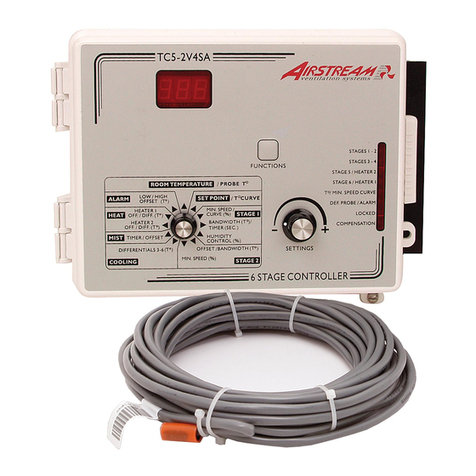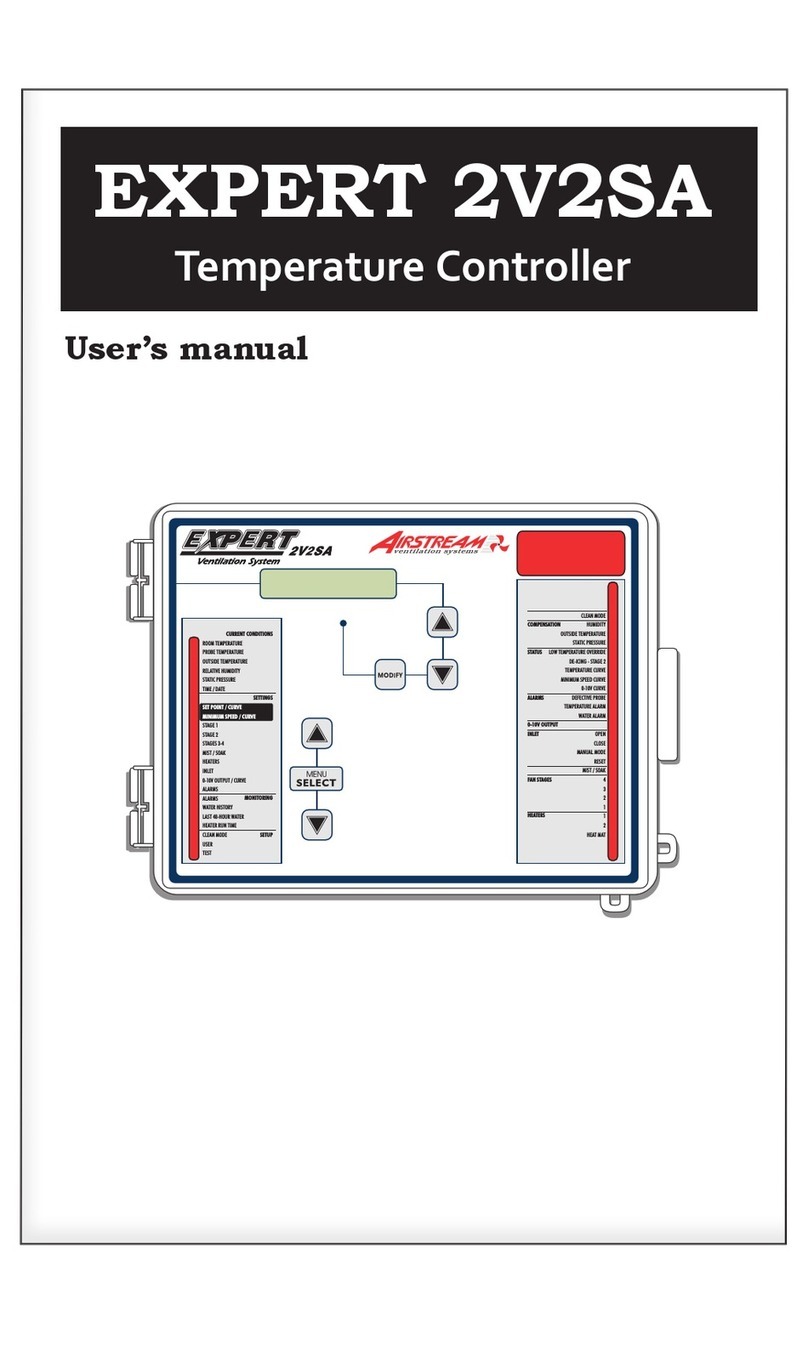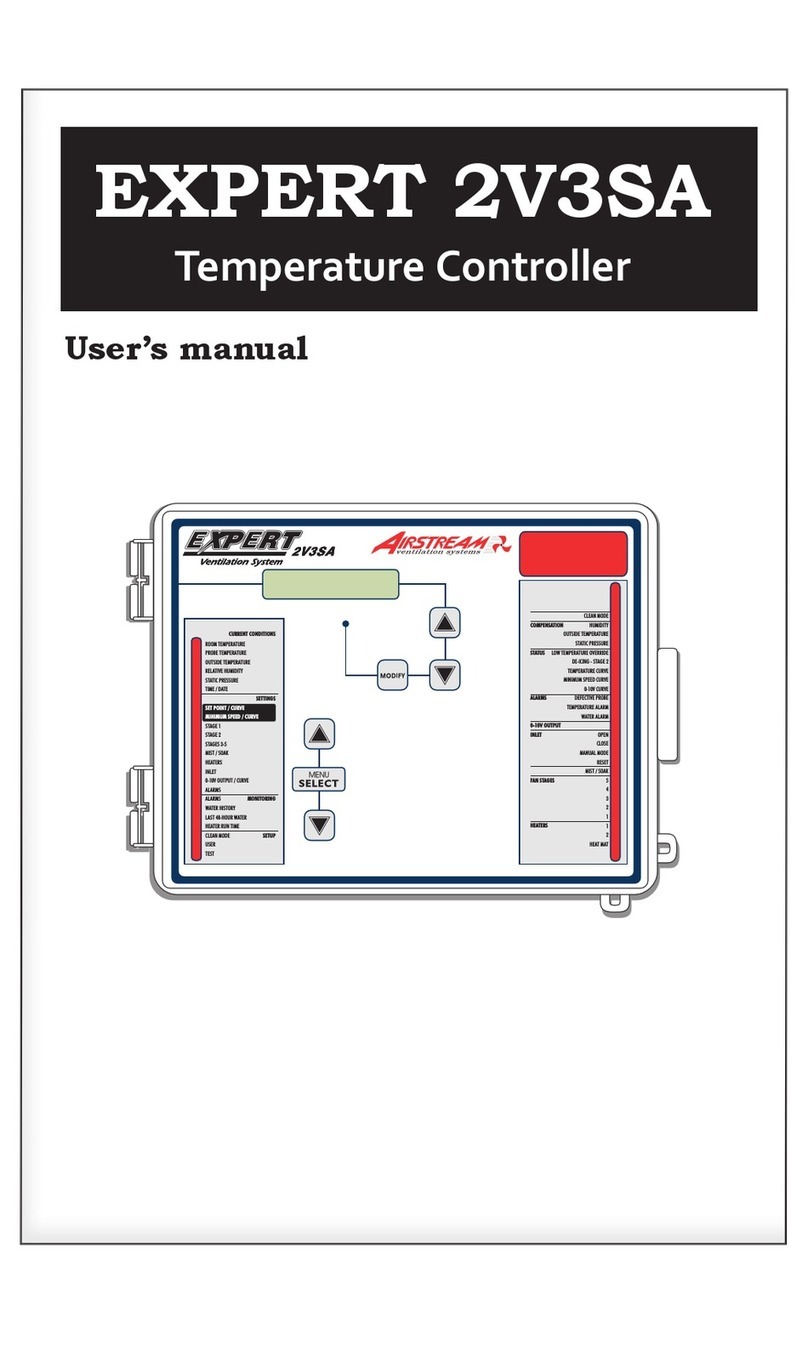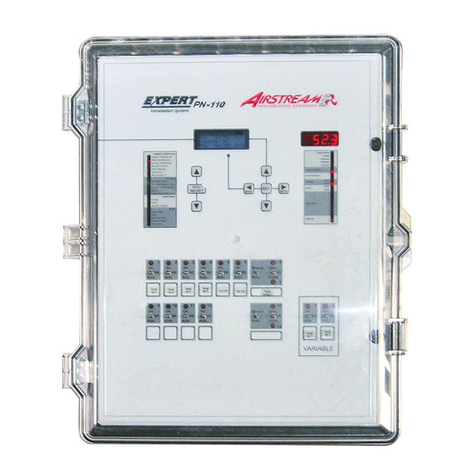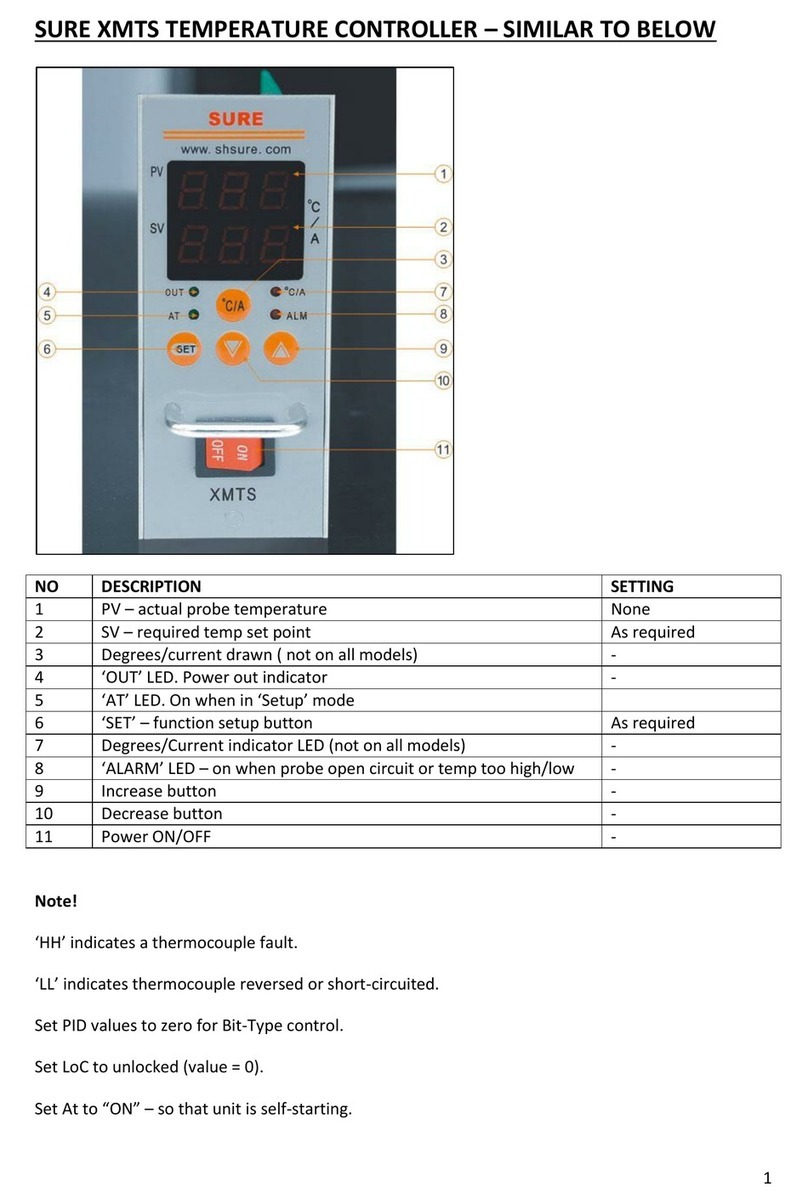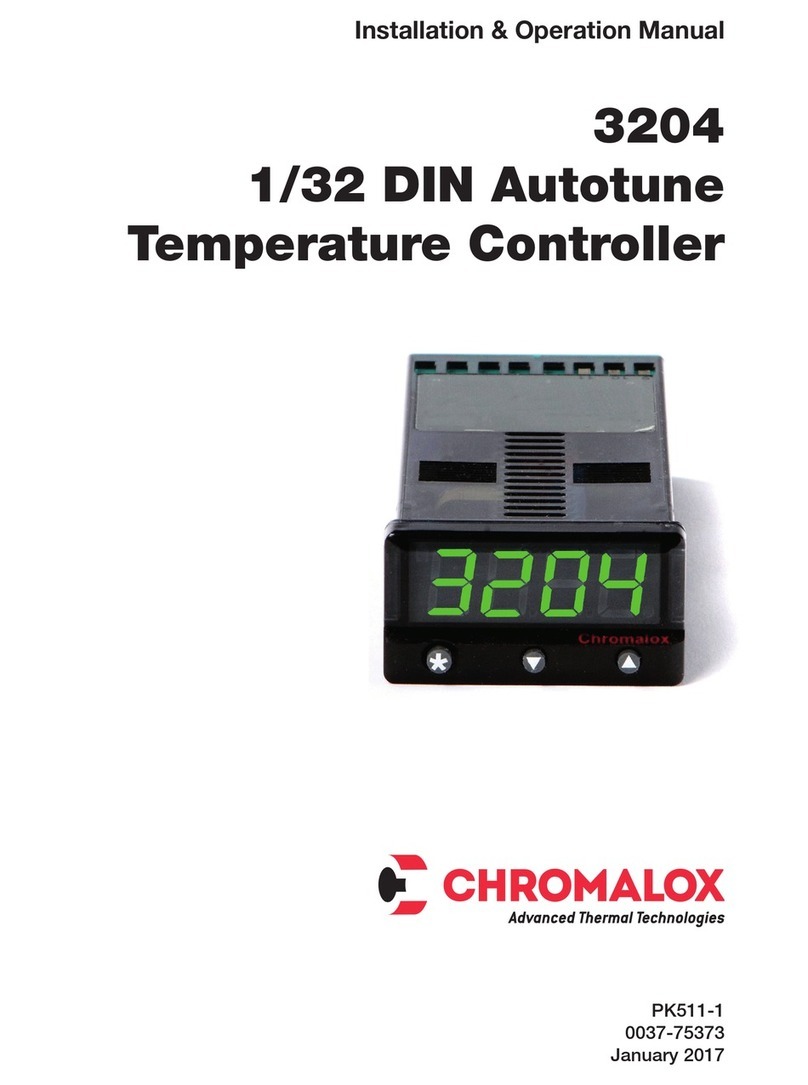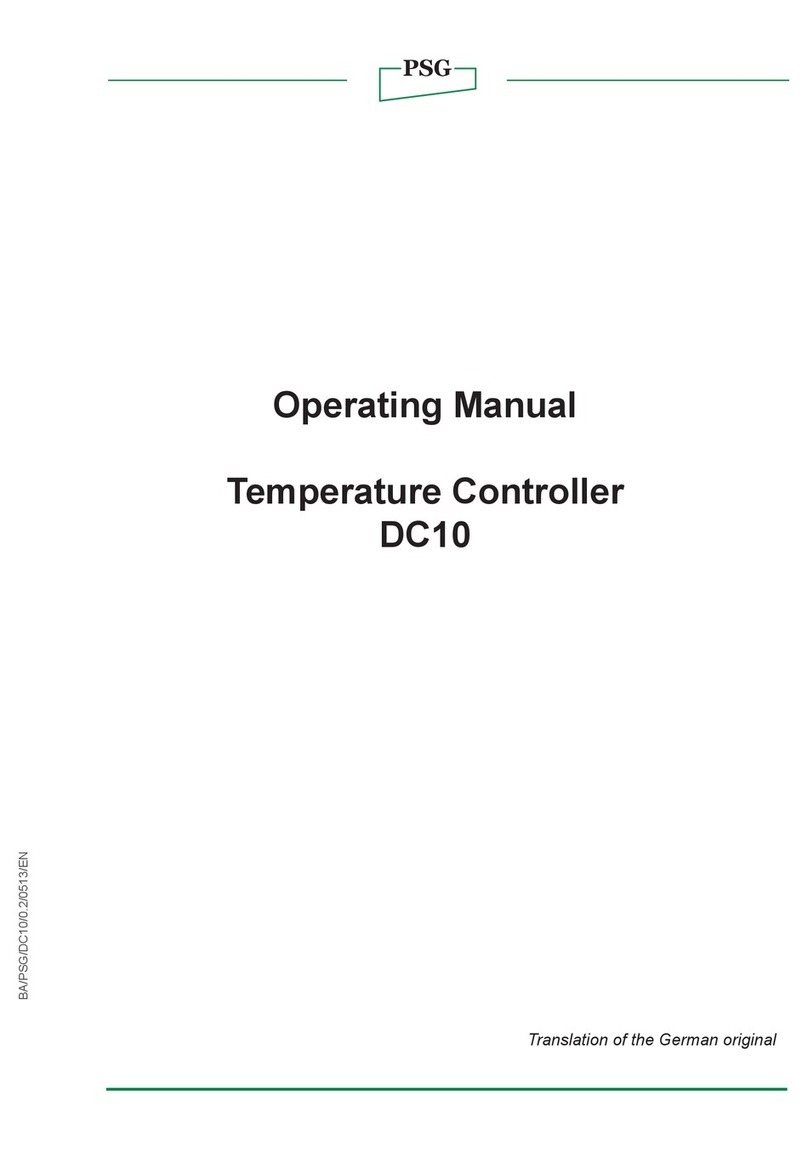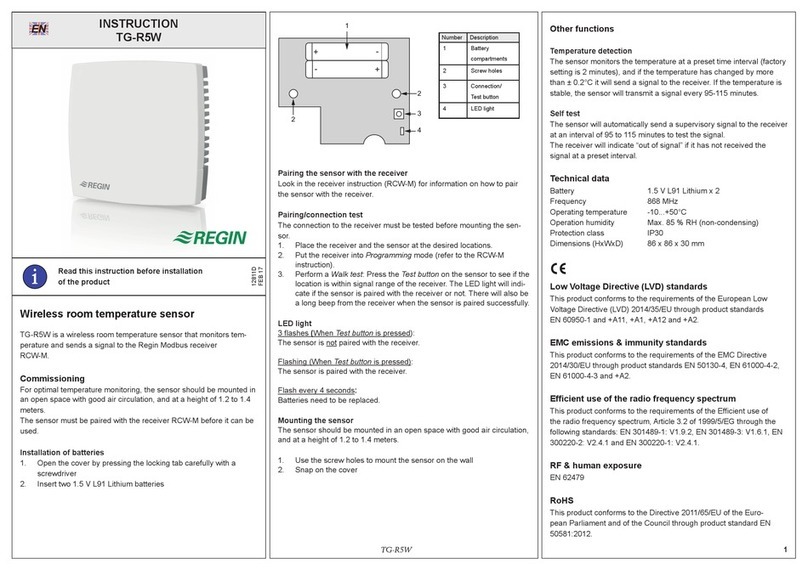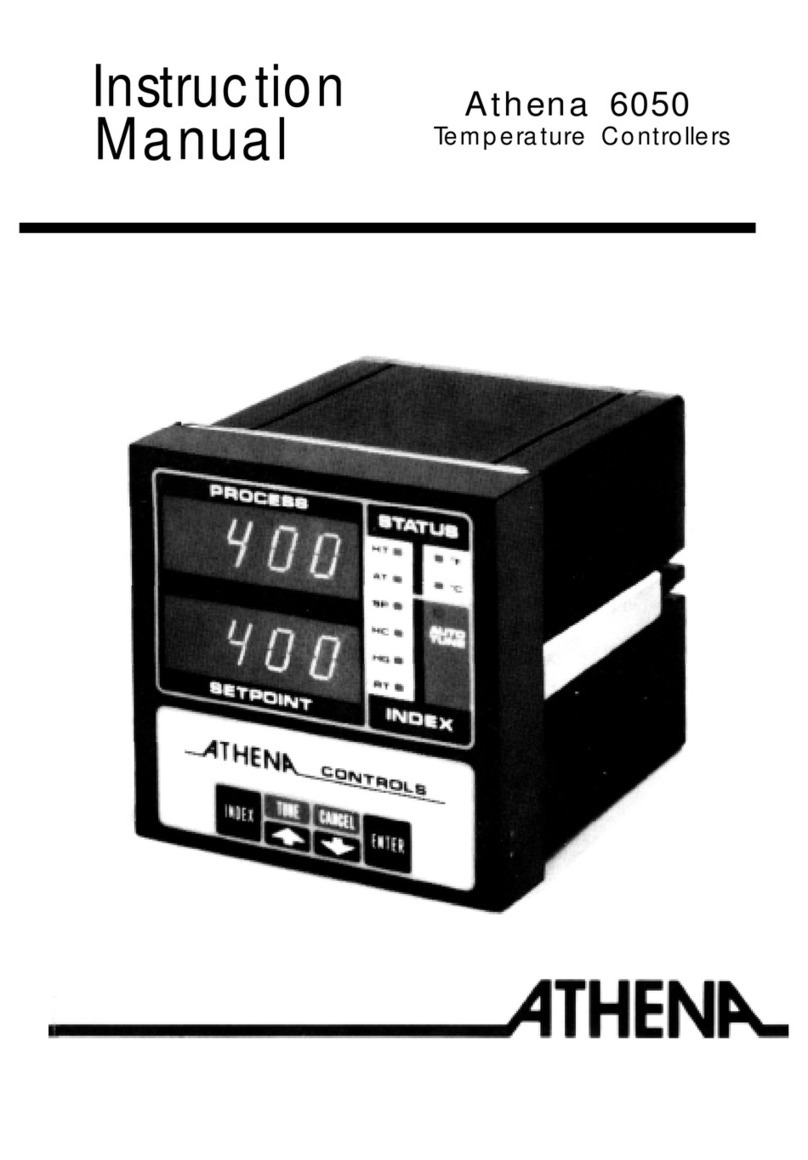Airstream INTER 2V4SA User manual

M 890-00505 rev.02 REV.02
INTER2V4SA
Temperature Controller
User’smanual
ALARMS
TEST MODE
OUTSIDE TEMP / OFFSET
ROOM TEMP / MIN / MAX
PROBE TEMP / MIN / MAX
RELATIVE HUMIDITY / MIN / MAX
SET POINT / TEMP RAMP
CURRENT RAMPING DAY
STAGE 1 MIN SPEED / RAMP
STAGE 1 BANDWITH / TIMER
STAGE 1 RH COMPENSATION
STAGE 1 MOTOR TYPE
STAGE 1 OVERRIDE MIN. SPEED
STAGE 2 MIN SPEED
STAGE 2 OFFSET / BANDWITH
STAGE 2 DE-ICING
STAGE 2 MOTOR TYPE
STAGE 3 - 6 DIFFERENTIAL
MIST OFFSET / DIFFERENTIAL
MIST TIMER
MIST RH COMPENSATION
HEATER 1 OFFSET / DIFFERENTIAL
HEATER 2 OFFSET / DIFFERENTIAL
VARIABLE STAGE 1
VARIABLE STAGE 2
STAGE 3
STAGE 4
STAGE 5
STAGE 6
MIST
HEATER 2
HEATER 1
RH COMPENSATION
TEMP RAMP
MIN SPEED RAMP
PROBE DEFECT
ALARM
%
°C / °F
SEC. / MIN.
LOCKED
STAGE 1STAGE 2
MIST
FUNCTIONS ADJUSTMENTS
OTHER FUNCTIONS
INTER 2V4SA

2INTER2V4SA,rev.02
INTER2V4SA
WARNINGS
The warranty can be void if this product
is used in a manner not specified by the
manufacturer.
Every effort has been made to ensure that
this manual is complete, accurate and up-
to-date. The information contained in it is
however subject to change without notice
due to further developments.
For Customer Use: Enter below the serial
number located on the side of the alarm
system and keep this information for future
reference.
Model: INTER 2V4SA
Serial number:
Date installed:
39
INTER2V4SA,rev.02
INTER2V4SA
MemoryCardTransferError:
CAUSE SOLUTION
The memory card is
write protected
If you want to copy the controller's configuration on the
memory card, make sure the switch at the bottom of the card
is at the unlocked position.
The controller is write
protected
If you want to transfer the card's configuration in the control-
ler, make sure internal switch #1 of the controller is at the OFF
position.
The memory card
is blank or its content
is incompatible with the
controller
Make sure a valid configuration is written on the card before
starting a transfer.
The transfer
is incomplete
Make sure the memory card is properly inserted in the connector
then retry the transfer. Do not move or hold the card while the
transfer is ongoing.
The memory card is defective, try with another card (contact
your dealer).
The connector is defective (contact you dealer).

38 INTER2V4SA,rev.02
INTER2V4SA
16. MemoryCard
The memory card is used to create a backup
copy of your controller’s configuration. The
card is also useful to transfer the configura-
tion of one controller to another controller of
the same type.
The switch at the bottom of the card is used
to lock or to unlock the card ( = locked,
= unlocked).
Turn off power each time you open the
controller’s enclosure. This prevents
accidental exposure to areas of high
voltage.
TOTRANSFERACONFIGURATION:
1. Open the latch and lift the controller's
cover.
2. If you are about to copy the controller's
configuration on the memory card, make sure
the card's switch is at the unlocked position.
3. Insert the card in the connector located
on the electric board inside the controller.
Refer to the illustration above to position the
memory card correctly.
4. If internal switch #12 is at
the OFF position, simply switch
it to the ON position; if internal
switch #12 is already at the ON
position: switch it back to OFF
and then ON again.
5. Close the controller's enclosure.
6. The transfer menu should be displayed on
screen. Use the adjustment buttons to select
whether you want to transfer the memory
card's content into the controller ("COPY"
"to""CTRL")or if you wish to transfer the
controller's content into the memory card
("COPY""to""CARD") .
12
ON
OFF
7. Once you have chosen the proper type of
transfer, press and hold the Other Functions
button for 5 seconds. The controller will au-
tomatically return to the ROOMTEMP menu
once the transfer is completed. If the transfer
is incorrect, the letters "COPY"and "Error"
will flash on screen. In this case, press the
up or down adjustment button to exit the
error menu and then refer to the table below
to see possible error causes.
8. Once the transfer is over, open the con-
troller's cover, and remove the memory card
from the connector. Close the controller's
enclosure afterwards.
9. Lock the card switch ( ) if required.
ON
OFF
Internal
switches
Memory
Card
Lock/Unlock
switch
Connector
Electronic
board
3
INTER2V4SA,rev.02
INTER2V4SA
1. PRECAUTIONS.............................. 4
2. FEATURES.................................... 4
3. LOCATIONOFTHECONTROLS....... 6
3.1. Unit Display .................................. 6
3.2. Internal Switches ........................... 6
3.3. Controller Status LEDS ................... 7
4. INSTALLATION.............................. 8
4.1. Mounting Instructions ..................... 8
4.2. Connections .................................. 8
4.3. Motor Types.................................. 8
4.4. Temperature Probes ....................... 9
5. CHANGINGAPARAMETER........... 10
5.1. Using the Display ......................... 10
5.2. Locking the Parameter Settings ...... 10
6. TEMPERATURESETTINGS............ 11
6.1. Temperature Units ....................... 11
6.2. Viewing Temperatures .................. 11
6.3. Temperature Set Point .................. 12
6.4. Temperature Ramp ....................... 13
7. FANSTAGES.............................. 15
7.1. Principle of Operation ................... 15
7.1.1. Merging Fan Stages 1 & 2 ....... 17
7.1.2. De-icing of Stage 2 Fans ......... 19
7.2. Fan Stage Settings ....................... 20
8. MINIMUMVENTILATIONCYCLES.. 22
8.1. Principle of Operation ................... 22
8.2. Minimum Ventilation Timer Settings 22
8.3. RH Compensation on the Min. Ventila-
tion Speed .................................. 23
8.4. Minimum Ventilation Speed Ramp .. 24
TABLEOFCONTENTS
9. MISTING..................................... 26
10. HEATINGSTAGES....................... 28
10.1. Cascade Heating .......................... 28
10.2. Zoned Heater .............................. 29
10.3. Heater Settings ............................ 30
11. ALARMS..................................... 31
11.1. Temperature Alarms ..................... 31
11.2. Outside Temp. Compensation on
Temp. Alarms .............................. 31
11.3. Alarm Settings ............................. 32
11.3.1. Hi/Lo Alarm Offsets & Critical
Alarm .................................... 32
11.3.2. Outside Temp. Alarm Offset .... 32
12. TESTMODE................................ 33
13. TROUBLESHOOTING.................... 34
14. TECHNICALSPECIFICATIONS....... 36
15. FACTORYSETTINGS................... 37
16. MEMORYCARD.......................... 38

4INTER2V4SA,rev.02
INTER2V4SA
1. Precautions
WARNING: Read and save these in-
structions!
Safety may be jeopardized if the equipment is
used in a manner not specified by the manu-
facturer. Carefully read and keep the following
instructions for future reference.
We strongly recommend installing supplemen-
tary natural ventilation as well as a backup
thermostat on at least one cooling stage.
Although fuses at the input and outputs of
the controller protect its circuits in case of
an overload or over-voltage, we recommend
installing an additional protection device on
the controller’s supply circuit.
The room temperature where the controller
is located must always remain between 32°F
and 104°F (0°C to 40°C). Indoor use only!
To avoid exposing the controller to harmful
gases or excessive humidity, it is preferable
to install it in a corridor.
If the equipment is used in a manner not
specified by the manufacturer, the protec-
tion provided by the equipment may be
impaired.
Do not spray water on the controller! In
order to clean the control, wipe it with a
damp cloth.
Before servicing or cleaning unit, switch
power off at service panel and lock the
switch disconnecting means to prevent
power from being switched accidentally.
When the service disconnecting means
cannot be locked, securely fasten a
prominent warning device, such as a
tag, to the service panel.
2. Features
The INTER 2V4SA is an electronic device
used for environmental control in livestock
buildings. It allows the user to maintain a
specified target temperature by controlling
the operation of ventilation and heating equip-
ment. The controller can control two stages
of variable speed fans and two stages of
either constant-speed fans or heating units.
In addition, one of the constant-speed fan
stages can be configured as a mist cooling
stage.
Five-digitdisplay:
A five-digit display provides a high level
of accuracy, allowing the user to specify a
temperature to within one tenth of a degree
(in Fahrenheit or Celsius units).
Pilotlights:
Pilot lights indicating the state of outputs
allow the user to monitor the operation
of the system without having to enter the
building.
Minimumventilationcycles:
When ventilation is not required for cooling,
the first stage fans can be operated either
continuously or intermittently to reduce the
level of humidity and supply oxygen to the
room.
Rampingfunctions:
Ramping functions provide an automatic
adjustment of the set point and minimum
ventilation fan speed over a given period
of time.
Choiceof10motortypes:
The variation in motor speed resulting from a
change in voltage will depend on the make and
capacity of the motor. In order to achieve a high
degree of compatibility between controller and
motor, the user can choose from among ten
different motor types, thus ensuring that the
correct voltage is supplied.
Zonedorcascadingheaters
37
INTER2V4SA,rev.02
INTER2V4SA
i) These initial parameter settings will not be re-
tained in the controller's memory. Each new setting
will replace the preceding one.
ii) If the power supply is cut off, the last parameter
settings will be retained in memory until the power
is restored.
15. FactorySettings
PARAMETER FACTORY
SETTING
RANGE
OFVALUES
Temperature Set Point 25,0°C (77,0°F) -40,0 to 48,9°C
(-40,0 to 120,0°F)
Outside T° Alarm Offset 1,0°C (1,8°F) 0,3 to 20,0°C
(0,5 to 36,0°F)
Stage 1 Minimum Speed 40% 10 % to 100 %
Time On 0 seconds 0 to 900 seconds in increments of 15 sec.
Time Off 15 seconds
Bandwidth 1,0°C (1,8°F) 0,3 to 10,0°C
(0,5 to 18,0°F)
Override Min
Speed
40% 10 to 100%
Humidity
Control
Humidity Set Point 65% 40 to 100%
Compensation
Percentage
60% 0 to 100% of stage 1 min speed
Stage 2 Offset 0,3°C (0,5°F) From set point to 10,0°C (18,0°F)
Bandwidth 1,0°C (1,8°F) 0,3 to 10,0°C (0,5 to 18,0°F)
Min. Speed 40% 10 % to 100 %
De-icing
Cycle Time
1 minute 1 to 720 minutes
De-icing Time 15 seconds 15 to 900 seconds
Stages 3-6 Differential 1,0°C (1,8°F) 0,3 to 10,0°C (0,5 to 18,0°F)
Mist Time On 60 seconds 0 to 900 sec. in increments of 15 sec.
Time Off 10 minutes 0 to 720 minutes
Offset 4,0°C (7,2°F) 0,3 to 20,0°C (0,5 to 36,0°F)
Differential 1,0°C (1,8°F) 0,3 to 10,0°C (0,5 to 18,0°F)
Mist Shut off
humidity level
95% 0 to 100%
Heater Heater Offset 1,0°C (1,8°F) -5,0 to 10,0°C (-9,0 to 18,0°F)
Max. Temperature
Diff. Btwn Zones
4,0°C (7,2°F) 0,3 to 20,0°C (0,5 to 36,0°F)
Alarms High Offset 7,0°C (12,6°F) 0,3 to 20,0°C (0,5 to 36,0°F)
Low Offset 5,0°C (9,0°F) 0,3 to 20,0°C (0,5 to 36,0°F)

36 INTER2V4SA,rev.02
INTER2V4SA
14. TechnicalSpecifications
Supply: 115/230 VAC (-18%, +8%), 50/60Hz, L1 same phases as
Stage 1 and 2, overload and overvoltage protection fuse
F12-1A fast blow.
Stage1: Variable output, 115 VAC (1/2 HP) / 230 VAC (1,5 HP),
Mot.10A, 50/60 Hz, fuse F1-15A slow blow.
Stage2: Variable output, 115 VAC (1/2 HP) / 230 VAC (1,5 HP),
Mot.10A, 50/60 Hz, fuse F2-15A slow blow.
Stage3: ON-OFF output, 115 / 230 VAC, 30VDC, 50 / 60 Hz,
Mot.10A, heating or cooling, fuse F3-15A slow blow.
Stage4: ON-OFF output, 115 / 230 VAC, 30VDC, 50 / 60 Hz,
Mot.10A, heating or cooling, fuse F4-15A slow blow.
Stage5: ON-OFF output, 115 / 230 VAC, 30VDC, 50 / 60 Hz,
Mot.10A, heating or cooling, fuse F5-15A slow blow.
Stage6: ON-OFF output, 115 / 230 VAC, 30VDC, 50 / 60 Hz,
Mot.10A, heating or cooling, fuse F6-15A slow blow.
Alarm: ON-OFF output, 3A, 115/230 VAC, 30VDC, fuse F11-3A
slow blow.
Probes: Low voltage ( < 5V), isolated from the supply. Operating
range: -40,0° to 48,9°C (-40,0° to 120,0°F). Accuracy:
1,0°C (1,8°F) between 5,0° and 35,0°C (41,0° and
95,0°F).
Enclosure: ABS, moisture and dust-tight.
Theroomtemperaturewherethecontrollerislocated
mustalwaysremainbetween0and40°C(32and
104°F).Indooruseonly!
5
INTER2V4SA,rev.02
INTER2V4SA
High-Lowtemperatureoutput
Humiditycompensation:
The stage 1 minimum speed can be adjusted
automatically as a function of relative hu-
midity. As humidity increases, the minimum
speed of stage 1 fans increases proportionally
to compensate for the change.
Fullspeedfanstart-up:
In order to overcome the inertia of the ven-
tilation system components and de-ice the
fan blades in cold weather conditions, the
controller supplies maximum voltage to the
variable speed fans during the 2 seconds im-
mediately following each start-up.
De-icingcycle:
A de-icing cycle is provided for de-icing
stage 2 variable-speed fans in cold weather
conditions.
Four independent temperature probe in-
puts:
Up to four temperature probes can be con-
nected to the controller in order to obtain a
more accurate reading of the average room
temperature and a faster reaction time.
Overloadandovervoltageprotection:
Fuses are installed at the input and outputs
of the controller to protect its circuitry in the
case of an overload or overvoltage.
Computercontrol:
The controller can be connected to a com-
puter, thus making it possible to centralize
the management of information and diversify
control strategies.
Controlofairinletmovement:
If the INTER 2V4SA is used in combination
with a PF-6 controller, the movement of the
air inlets can be coordinated with the opera-
tion of the fans using a potentiometer located
on the panel drive. This allows the air inlets to
be adjusted correctly, without the influence
of uncontrollable factors such as wind or air
from adjoining rooms.
Testmode:
A test mode allows you to simulate tem-
perature changes and verify controller per-
formance.

6INTER2V4SA,rev.02
INTER2V4SA
3. LocationoftheControls
Internal switches
LED Meaning
°C/° F "Flashes when the temperature
displayed is in Celsius degrees.
Turns on when the temperature
displayed is in Fahrenheit degrees.
"
% Turns on when the value displayed
is a percentage.
Sec/min Flashes when a value is displayed
in seconds; turns on when it is
displayed in minutes.
Locked Turns on when parameters are
locked (internal switch #1 is ON)
# OFF ON
1 Unlocked parameters Locked parameters
2 Fahrenheit degrees Celsius degrees
3 Probe 2 disabled Probe 2 enabled
4 Probe 3 disabled Probe 3 enabled
5 Probe 4 disabled Probe 4 enabled
6 No heating stage With heating
stage(s)
7 1 Heater 2 Heaters
8 Cascading heaters Zoned heaters
9 Mist deactivated Mist activated
10 Adjustable hysteresis Fix hysteresis of
1.0°C (1.8°F)
11 De-icing disabled De-icing enabled
12 Switch from off to on to acces the transfer
menu
3.2. InternalSwitches
Internal switches are located on the inside
the controller's front cover. All switches are
set to OFF when the controller is shipped
from the factory.
3.1. UnitDisplay
The pilot lights on the right of the display
indicate the units of the value currently
displayed.
ON
OFF
ALARMS
TEST MODE
OUTSIDE TEMP / OFFSET
ROOM TEMP / MIN / MAX
PROBE TEMP / MIN / MAX
RELATIVE HUMIDITY / MIN / MAX
SET POINT / TEMP RAMP
CURRENT RAMPING DAY
STAGE 1 MIN SPEED / RAMP
STAGE 1 BANDWITH / TIMER
STAGE 1 RH COMPENSATION
STAGE 1 MOTOR TYPE
STAGE 1 OVERRIDE MIN. SPEED
STAGE 2 MIN SPEED
STAGE 2 OFFSET / BANDWITH
STAGE 2 DE-ICING
STAGE 2 MOTOR TYPE
STAGE 3 - 6 DIFFERENTIAL
MIST OFFSET / DIFFERENTIAL
MIST TIMER
MIST RH COMPENSATION
HEATER 1 OFFSET / DIFFERENTIAL
HEATER 2 OFFSET / DIFFERENTIAL
VARIABLE STAGE 1
VARIABLE STAGE 2
STAGE 3
STAGE 4
STAGE 5
STAGE 6
MIST
HEATER 2
HEATER 1
RH COMPENSATION
TEMP RAMP
MIN SPEED RAMP
PROBE DEFECT
ALARM
%
°C / °F
SEC. / MIN.
LOCKED
STAGE 1STAGE 2
MIST
FUNCTIONS ADJUSTMENTS
OTHER FUNCTIONS
INTER
2V4SA
Main menu
LED Display
Status LEDs
Units
Adjustment but-
tons
Menu selectors
35
INTER2V4SA,rev.02
INTER2V4SA
PROBLEM CAUSE SOLUTION
Stage 1 or 2 fans run
erratically.
The selected motor ramp is not
correct.
Select an appropriate motor ramp.
The differential is too small. Adjust the differential to a higher value.
The On Time or Off Time is too
short.
Adjust the On Time or Off Time to a
higher value.
Stage 1 fans do not stop
running when the control-
ler is operating in mini-
mum ventilation cycle.
Off Time is set to zero. Set the Off Time to a value other than
zero.
The wiring is incorrect. Correct the wiring. In particular, make
sure two different lines are connected
to each motor: line L1 modulated by
the controller should be combined
with another line (N for 115V or L2 for
230V) to activate the motor. Also, be
sure the stage 1 COMMON is supplied
by line L1.
Humidity compensation is
activated and relative humidity
exceeds set point.
Adjust set point or deactivate compen-
sation as required.
Stage 3, 4, 5 or 6 is not
operating.
The Stage's fuse is open. Replace the fuse.
The display board interconnect
cable is not plugged into the
power supply board properly.
Make sure the cable is firmly plugged
in with the tabs in place.
The wiring is incorrect. Correct the wiring. In particular, make
sure two different lines are connected
to each motor: line L1 modulated by
the controller should be combined
with another line (N for 115V or L2 for
230V) to activate the motor or heating
unit. Also, make sure the Stage COM-
MON is supplied by line L1.
The fan motor or heating unit is
defective.
Verify if the motor or heating unit is de-
fective by connecting it to an alternate
power supply. Replace the motor or
heating unit If it still is not operating.
The controller is defective. Listen to see if there is a clicking sound
when the Stage's pilot light turns on. If
there is no clicking sound, contact your
distributor to repair the controller.

34 INTER2V4SA,rev.02
INTER2V4SA
13. Troubleshooting
PROBLEM CAUSE SOLUTION
The display doesn't work. The circuit breaker on the ser-
vice panel is off or tripped.
Reset the circuit breaker.
The wiring is incorrect. Fix the wiring.
The input fuse is open. Replace the fuse.
The voltage selector switch is in
the wrong position.
Set the switch to the correct position.
The display board interconnect
cable is unplugged from the
power supply board.
Plug the cable.
The display shows the
letter "P"
Probe # 1 not properly con-
nected
Connect probe #1 correctly
The Defective Probe Pilot
Light is on.
One or more probes are defec-
tive.
Follow the procedure described in
DEFECTIVE PROBES to identify and
replace the defective probe.
The display shows sud-
den variations in room
temperature.
A variation in resistance is
induced on a probe.
Make sure the probes are dry and move
them away from drafts and sources of
radiant heating.
There is electrical noise near an
extended probe cable.
Do not run probe cables next to other
power cables. When crossing other
power cables, cross at 90°.
Stage 1 or 2 fans are not
running.
The wiring is incorrect. Correct the wiring. In particular, make
sure two different lines are connected
to each motor: line L1 modulated by
the controller should be combined
with another line (N for 115V or L2 for
230V) to activate the motor. Also, be
sure the Stage 1 and 2 COMM is sup-
plied by line L1.
The Stage's fuse is open. Replace the fuse.
The display board interconnect
cable is not plugged into the
power supply board properly.
Make sure the cable is firmly plugged
in with the tabs in place.
The minimum speed is too low. Adjust the minimum speed to a higher
value.
The fan motor is defective. Check if motor is defective by con-
necting it to an alternate power supply.
Replace the motor if it still doesn't
operate.
Stage 1 or 2 fans run
continuously at full
speed.
The wiring is incorrect. Fix the wiring.
The ambient temperature is
above the set point.
Adjust the set point to the desired
value.
7
INTER2V4SA,rev.02
INTER2V4SA
3.3. ControllerStatusLEDS
LED Meaning
VARIABLE STAGE 1 Turns on when variable fan stage 1 fans is active.
VARIABLE STAGE 2 Turns on when variable fan stage 2 fans is active.
STAGES 3-6 Turns on when fan stage 3-6 is active.
MIST Turns on when the mist stage is active.
HEATER 1 Turns on when heating stage 1 is active.
HEATER 2 Turns on when heating stage 2 is active.
RH COMPENSATION Turns on when a RH compensation function is on.
TEMP RAMP Turns on when the temperature ramp is enabled.
MIN SPEED RAMP Turns on when the minimum speed ramp is enabled
PROBE DEFECT Turns on when a probe is defective.
ALARM Turns on when an alarm condition is detected.

8INTER2V4SA,rev.02
INTER2V4SA
AlarmConnection:
There are two types of alarms on the market.
One type activates when current is cut off
at its input; the other type of alarm activates
when current is supplied at its input. For an
alarm of the first type, use the NO terminal as
shown on the wiring diagram. For an alarm of
the second type, use the NC terminal.
All wiring must be done by an autho-
rized electrician and must comply with
applicable codes, laws and regulations.
Make sure power is off before doing any
wiring to avoid electrical shocks and
equipment damage.
4.3. MotorTypes
The relationship between the voltage sup-
plied to a motor and its operating speed is
described by a motor ramp. This ramp varies
with the make and capacity of the motor. The
various motors available in the industry have
been divided into ten categories and the con-
troller has been programmed with a different
motor ramp for each of these categories. To
ensure that the controller supplies the cor-
rect voltages, an appropriate ramp must be
selected for stage 1 and stage 2 according
to the type of fan motors used.
I. SelectingaMotorTypeforStage
1andStage2
The installation guide enclosed with your
controller contains a list of all motor types.
• Select the motor type menu of stage 1
or stage 2. The motor type of the selected
stage is displayed, alternating with letters
"tYPE".
• Use the adjustment buttons to set the motor
type to the desired value.
4. Installation
4.1. MountingInstructions
Open the latch and lift the cover. Remove the
black caps located on each of the four mounting
holes. Mount the enclosure on the wall using
four screws. Be sure the electrical knockouts
are at the bottom of the enclosure in order to
prevent water from entering the controller. Insert
the screws in the mounting holes and tighten.
Fasten the four black caps provided with the
controller onto the four mounting holes. The
enclosure must be mounted in a location that
will allow the cover to be completely opened
right up against the wall.
4.2. Connections
Refer to the wiring diagram enclosed with this
user’s manual to connect the controller. Drill
holes at the bottom of the enclosure to pass
the wires and install watertight connectors to
prevent water from entering in the enclosure.
Do not make any holes at the side and top of
the enclosure.
• Set the voltage switch to the appropriate
voltage.
• If Stage 5 or 6 is used for heating, it may
be necessary to install a transformer in or-
der to supply the appropriate voltage to the
heating unit.
33
INTER2V4SA,rev.02
INTER2V4SA
12. TestMode
A test mode allows you to simulate tempera-
ture changes and verify the performance of
your controller. In test mode, the tempera-
ture probe inputs are turned off, allowing to
change the temperature used by the con-
troller to operate the stages. The controller
operates as before using the new temperature
settings.
Enabling/disablingthetestmode:
• Select the TEST MODE. The test mode
status is displayed.
• Use the adjustment buttons to select the
desired test mode status (On or Off).
Settingthetestmodetemperature:
• Once the test mode is enabled, press the
push button. The test mode temperature is
displayed, alternating with the letters "tst".
The test mode automatically ends after
4 minutes of inactivity.

32 INTER2V4SA,rev.02
INTER2V4SA
OutsideT°Compensation
onHighT°Alarms
Outside
Temp.
Time
Room
T°
Alarm
Limit
Set
Point
Normal temperature range (no alarm)
Alarm : temperature out of range
Hi OffsetLo Offset
11.3. AlarmSettings
11.3.1.Hi/LoAlarmOffsets&Criti-
calAlarm
Hi & lo alarm offsets range from 0,3 to
20,0°C (0,5°F to 36,0°F) and the critical
alarm limit ranges from the high alarm limit
to 49,0°C (120,0°F).
• Select the ALARMSmenu. The low alarm
offset flashes on the display, alternating with
the word "LoAL". Use the adjustment buttons
to set it to the desired value.
• Press the Other Functions button. The high
alarm offset flashes on the display, alternating
with the word "HIAL". Use the adjustment
buttons to set it to the desired value.
• Press the Other Functions button. The alarm
type "TyPE" is displayed, alternating with the
word "ALL" or "Ind".
• Use the adjustment buttons to select de-
sired option :
• Select "ALL" for temperature alarms to
sound when the average temperature of
all probes exceeds the normal temperature
range; Select "Ind" for temperature alarms to
sound when the temperature of an individual
probe exceeds the limits.
• Press the Other Functions button. The criti-
cal alarm limit is displayed, alternating with
the word "CrAL". Use the adjustment buttons
to set it to the desired value.
11.3.2.OutsideTemp.AlarmOffset
The outside temperature alarm offset deter-
mines when an alarm sets off when the room
temperature gets higher than the outside
temperature. This parameter ranges from 0,3
to 20,0°C (0,5°F to 36,0°F).
• Select the OUTSIDETEMP./OFFSETmenu.
The current outside temperature is displayed.
The letter "P" is displayed if no probe is con-
nected to the outside temperature input.
• Press the Other Functions button. The out-
side temperature alarm offset flashes on the
display, alternating with the word "OFSEt".
• Use the adjustment buttons to set it to the
desired value.
9
INTER2V4SA,rev.02
INTER2V4SA
4.4. TemperatureProbes
The controller is supplied with one tempera-
ture probe connected to input #1. Up to three
additional probes can be connected to the
controller in order to obtain a more accurate
reading of the average room temperature and
a faster reaction time.
I. ConnectingtheProbes
• Connect additional probes to
inputs # 2, 3 and 4 as shown on
the wiring diagram and then use
dipswitches 3-5 to enable the
proper inputs:
# OFF ON
3 Probe 2 disabled Probe 2 enabled
4 Probe 3 disabled Probe 3 enabled
5 Probe 4 disabled Probe 4 enabled
II. ExtendingtheProbes
Probes operate at low voltage and are
isolated from the supply. Be sure that
probe cables remain insulated from all
high voltage sources. In particular, do
not route the probe cables through the
same electrical knockout as other cables.
Do not connect the shield from the probe
cable to a terminal or a ground.
Extendingaprobe: Each probe can be ex-
tended up to 500 feet (150 meters).
To extend a probe: Use a shielded cable of
outside diameter between 0.245 and 0.260
in (6.22 and 6.60 mm) (the cable dimensions
should not be under 18 AWG) to ensure the
cable entry is liquid tight. Do not ground
theshielding.
It is preferable to solder the cable joint to
ensure a proper contact between the two
cables.
ON
OFF
Do not run probe cables next to other
power cables. When crossing over other
cables, cross at 90°.
III. DefectiveProbes
If a defective probe is detected, the Defective
Probe Pilot Light turns on. The room tempera-
ture shown on the display corresponds to the
average temperature measured by the probes
in working condition.
To identify the defective probe:
• Select the PROBETEMP/MIN/MAXmenu.
If the probe connected to input # 1 is not
defective, the letters "PR1" are displayed,
alternating with the on/off state of the probe
and the temperature measured by the probe.
If the probe is defective, the letters "PR1" are
displayed, alternating with the state of the
probe and the letter "P".
• Press the Other Functions button to step
to the following probe.
• Proceed as explained above to make sure
all probes are in working order.

10 INTER2V4SA,rev.02
INTER2V4SA
5. ChangingaParameter
5.1. UsingtheDisplay
FlashingValues:The display
will flash in certain cases
and not in others. The flash-
ing indicates that the value
shown can be adjusted. A
value that is not flashing
cannot be adjusted.
RelativeandAbsoluteValues:Some param-
eter adjustments are displayed both as a
relative value and an absolute temperature.
This applies all heating and cooling differ-
entials, the mist differential and the heater
offset. The parameter is first displayed as a
relative value. The corresponding absolute
temperature is displayed after six seconds if
no action is taken by the user. The absolute
value is the temperature at which the stage
turns on (except in the case of the heater and
mist offsets where the value displayed is the
temperature at which the stage turns off). If
the user presses a button, the relative value
reappears. For example, when the user se-
lects a differential menu, i.e. STAGES 3-6DIF-
FERENTIAL, the sequence is as follows:
(i) The current differential for stage 3 flashes
on the display, alternating with "3dIF".
3 d I F
2 . 0
(ii) If, after about 6 seconds, no action is
taken by the user, the absolute temperature
value is displayed, alternating with "St3On".
In this case, the absolute value is: Set Point
+ Bandwidth 1 + Offset 2 + Bandwidth 2
+ Differential 3.
78 .0
ST3on
2 . 0
(iii) When the user presses on an adjustment
button to make an adjustment to differential,
the relative value reappears on the display.
2 . 3
5.2. LockingtheParameter
Settings
The parameter settings can be locked to pre-
vent accidentally modifying them. When the
settings are locked, only the temperature set
point and the Stage 1 minimum ventilation
speed can be modified (as long as the tem-
perature ramp and the minimum ventilation
speed ramp are deactivated respectively).
• Set internal switch # 1 to ON
to lock the parameters. The
"Locked Parameter" status LED
turns on.
• Set internal switch # 1 to OFF
to unlock the parameters. The
"Locked Parameter" status LED
turns off.
ON
OFF
1
1
ON
OFF
31
INTER2V4SA,rev.02
INTER2V4SA
11. Alarms
The controller sets off an alarm in the case
of a power failure, a fault in the supply circuit
or a high or low temperature.
11.1. TemperatureAlarms
The diagram below explains how temperature
alarms are detected. When the average room
temperature exceeds the high temperature
alarm setting (Set Point + Hi Offset), a high
temperature alarm sets off. When the aver-
age room temperature decreases below the
low temperature alarm limit (Set Point - Lo
Offset), a low temperature alarm sets off.
The criticaltemperatureis the absolute maxi-
mum allowable temperature in the room.
Temperature
Alarms
Alarm
RoomT°
Time
Set
Point
Normal temperature range (no alarm)
Alarm : temperature out of range
Hi OffsetLo Offset
11.2. OutsideTemp.Com-
pensationonTemp.
Alarms
In situations where the outdoor temperature
is high, the room temperature will rise as
warm air enters the building through ven-
tilation inlets. If the high set point is not
adjusted to take this into account, a high
temperature alarm may be needlessly set
off. To avoid this situation, the system can
compensate for high outdoor temperatures
when monitoring temperature alarms. When
this feature is activated and the outdoor
temperature is close to the high set point,
the room temperature is monitored with re-
spect to the outdoor temperature. An alarm
sets off only if the room temperature rises
above the outdoor temperature by a certain
value called the offset. In addition to this, the
system also uses a critical high temperature
as an absolute limit on room temperature.
When room temperature reaches the critical
high temperature, an alarm is set off. This
compensation feature is automatically en-
abled when an outside temperature probe is
connected to the controller.
OutsideT°Offset: In general, the room tem-
perature is greater than the outdoor tempera-
ture by a certain number of degrees, called
the offset. The offset determines when an
alarm sets off. It is the number of degrees the
room temperature can rise above the outdoor
temperature without setting off an alarm.

30 INTER2V4SA,rev.02
INTER2V4SA
10.3. HeaterSettings
I. AdjustingHeaterOffsets
The heater offset can provide substantial
energy savings if correctly adjusted accord-
ing to the outside temperature. This offset
represents the number of degrees below the
set point at which the heating units turn off
(see diagram above). The offset of heaters 1
and 2 can be adjusted from -5,0°C to 10,0°C
(-9,0°F to 18,0oF). If the offset is negative,
the heating units will turn off at temperatures
above the set point. If the controller uses
cascade heaters , only Heater 1 offset has
to be set.
• Select the HEATER1OFFSET/DIFFEREN-
TIAL or HEATER 2 OFFSET/DIFFERENTIAL
menu. The current heater offset is displayed,
alternating with the letters "OF.SET".
• Use the adjustment buttons to set it to the
desired value.
II. AdjustingHeaterDifferentials
The heating differential is the temperature
difference between the moment the heat-
ing units turn on and the moment they turn
off (see diagram above). It can be adjusted
between 0,3°C and 10,0°C (0,5°F and
18,0°F).
• Select the HEATER1OFFSET/DIFFEREN-
TIAL or HEATER 2 OFFSET/DIFFERENTIAL
menu.
• Press the Other Functions button. The
differential is displayed, alternating with the
letters "dIF".
• Use the adjustment buttons to set it to the
desired value.
III. Adjusting the Max. T° Differ-
enceBetweenZones
When using zoned heating, a built-in protec-
tion will operate the fans according to the
zone 1 probes whenever the temperature
difference between zones is greater than this
parameter. The default value is 4,0°C (7,2°F)
and values range from 0,3 °C to 20,0°C
(0,5°F to 36,0°F).
• Select the HEATER2—OFFSET/DIFFER-
ENTIALmenu.
• Press the Other Functions button twice. The
maximum temperature difference between
zones is displayed, alternating with the let-
ters "ZndiF.".
• Use the adjustment buttons to set this
parameter to the desired value.
11
INTER2V4SA,rev.02
INTER2V4SA
6. TemperatureSettings
6.1. TemperatureUnits
To select the desired measuring units used
to display temperatures, set internal switch
# 2 to the desired position:
ON: to display temperatures in
Celsius units.
OFF: to display temperatures in
Fahrenheit units.
6.2. ViewingTemperatures
I. ViewingtheRoomTemperature
The room temperature is the average value
of all temperatures measured by activated
probes in proper operating condition.
• Select the ROOMTEMPMIN/MAXmenu.
The average room temperature is displayed.
II. ViewingProbeTemperatures
The controller can display probe temperatures
individually. Probes can also be turned on or
off to control the temperature in different
parts of the building.
• Select the PROBE TEMP / MIN / MAX
menu. The temperature reading of probe 1
is displayed, alternating with letters "Pr1"
and the on/off state of the probe.
• Press the Other Functions button. The let-
ters "Pr1" are displayed, alternating with the
temperature reading from probe 1 and the on/
off state of the probe.
• For each additional probe, Other Functions
button. The letters "Prx" are displayed, al-
ternating with the temperature reading from
probe x and the on/off state of the probe.
2
ON
OFF
ON
OFF
2
III. Viewing Minimum / Maximum
Temperatures
Follow this procedure to see the lowest and
highest room temperature values that have
been recorded since the last reset.
• Select the ROOMTEMPMIN/MAXmenu.
The average room temperature is displayed.
• Press the up-arrow adjustment button. The
maximum temperature is displayed, alternat-
ing with the letters "Hi".
• Press the down-arrow adjustment button.
The average temperature is displayed. Press
the down-arrow adjustment button once
again. The minimum temperature is dis-
played, alternating with the letters "Lo".
NOTE: If you let the display flash for more
than 10 seconds, the controller resets the min
and max temperatures currently in memory
to the current average room temperature. To
avoid resetting these values, return to the
average temperature display using the adjust-
ment button (up-arrow or down-arrow) before
the 10 second delay has elapsed.
IV. Viewing Min/Max Probe Tem-
peratures
Follow this procedure to see the lowest and
highest temperature readings that have been
recorded by each probe since the last reset.
• Select the PROBE TEMP / MIN / MAX
menu. The temperature reading of probe 1 is
displayed, alternating with the letters "Pr1"
and the on/off state of the probe.
• Press the up-arrow adjustment button. The
maximum temperature of probe1 is displayed,
alternating with the letters "Pr1Hi".
• Press the down-arrow adjustment button.
The current temperature of probe 1 is dis-
played once again.

12 INTER2V4SA,rev.02
INTER2V4SA
• Press the down-arrow adjustment button
once more. The minimum temperature of
probe 1 flashes on the display, alternating
with the letters "Pr1Lo".
• Press the up-arrow adjustment button. The
current temperature of probe 1 is displayed
once again.
• Press the Other Functions button to select
another probe then proceed as explained
above to see the minimum and maximum
temperature readings of the desired probe.
NOTE: If you let the display flash for more
than 10 seconds, the controller resets the min
and max temperatures currently in memory
to the current average room temperature. To
avoid resetting these values, return to the
average temperature display using the adjust-
ment button (up-arrow or down-arrow) before
the 10 second delay has elapsed.
6.3. TemperatureSetPoint
The temperature set point is the target
room temperature. It can be adjusted be-
tween -40,0°C and 48,9°C (-40,0°F and
120,0°F).
I. AdjustingtheSetPoint
• Select the SETPOINT/TEMPRAMPfunc-
tion. The current set point flashes on the
display.
• Use the adjustment buttons to set this
parameter to the desired value.
The temperature set point can only be
adjusted while the temperature ramp is
disabled (see following section).
29
INTER2V4SA,rev.02
INTER2V4SA
10.2. ZonedHeater
To configure your system for zoned heaters,
set internal switch #8 to ON. Since the two
heater outputs function independently, dif-
ferent probes are assigned to each output:
Probes 1 and 2 are assigned to Heater 1 and
Probes 3 and 4 are assigned to Heater 2. In-
dividual probes can be turned on or off using
the internal switch settings. If both probes
are activated for a given heater, the average
temperature from both probes is used.
Both heating zones can have negative and
positive heater offsets. A negative offset
is used when controlling heat mats, for
example.
To avoid ventilation problems when using
zoned heating, a special protection is built
into the device. Suppose the animals are
young and confined to one part of the build-
ing (zone 1) while the rest of the building is
heated at a minimum level (zone 2). If the
temperature difference between zones is
too great and zone 1 fans operate according
to the average temperature for both zones,
cooling in zone 1 may be insufficient. A built-
in protection will operate the fans according
to the probes of the zone with the highest
temperature whenever the temperature dif-
ference between zones is greater than a
user-defined value.
Zone2
Probes 3 & 4 Probes 1 & 2
Young animals
Not used :
minimum heat
Zone1
ZonedHeater
Heating
Stage
Status
T°
Off
On
Set Point
Heater
Offset
Heater
Differential
Iftheroomtemperaturerises:
• at Set Point - Heater Offset 1 (Probes 1-2):
Heater 1 turns off.
• at Set Point - Heater Offset 2 (Probes 3-4):
Heater 2 turns off.
Iftheroomtemperaturefalls:
• at Set Point - Heater Offset 1 - Differential
1 (Probes 1-2): Heater 1 turns on.
• at Set Point - Heater Offset 2 - Differential
2 (Probe 3-4): Heater 2 turns on.

28 INTER2V4SA,rev.02
INTER2V4SA
10.1. CascadeHeating
When cascade heating is used, the operation
of heating stages is based on the average
room temperature (set internal switch #8 in
"OFF" position to enable cascade heaters).
Iftheroomtemperaturerises:
• at Set Point - Heater 1 Offset - Heater 1
Differential: Heater 2 turns off.
• at Set Point - Heater 1 Offset: Heater 1
turns off.
Iftheroomtemperaturefalls:
• at Set Point - Heater 1 Offset - Heater 1
Differential: Heater 1 turns on.
• at Set Point - Heater 1 Offset - Heater 1
Differential - Heater 2 Differential: Heater 2
turns on.
10. HeatingStages
Set internal switches as follows to enable
the proper number of heating stages (1 or
2 heating stages):
Positionof
theinternal
switches
Stage5
isusedfor:
Stage6
isusedfor:
6 ON / 7 OFF Cooling Heating
6 ON / 7 ON Heating Heating
CascadeHeating
Heating
Stage
Status
Stage 2 ON
Stage 2 OFF
Stage 1 ON
Stage 1 OFF
Set Point
Heater 1
Offset
Heater 1
Differential
Heater 2
Differential
RoomT°
13
INTER2V4SA,rev.02
INTER2V4SA
6.4. TemperatureRamp
The user can define a temperature ramp to
adjust the set point automatically over a given
period of time.
A ramp is composed of 10 steps. Each step
specifies a day number and a temperature set
point for that day (the day number refers to
the animal age). Once the ramp is activated,
the controller changes the set point every
hour in a linear fashion between consecutive
steps of the ramp. When the last step is
reached, the controller keeps using the tem-
perature set point associated to that day.
Temperature
90.0
87.2
84.4
81.6
78.8
76.0
73.2
70.4
67.6
64.8
62.0
1 5 10 14 19 24 28 33 38 42 47 Day
Temperature
SetPointRamp
Notes: Certain restrictions apply to reduce
the risk of errors:
1. The highest possible day number is 255.
2. Decreasing day numbers are not allowed.
3. Increasing temperatures are not al-
lowed.
4. The temperature variation cannot exceed
1,5°C (2,7°F) per day.
5. All ten steps must be specified. If you
don’t need ten different steps, repeat the last
temperature for each unnecessary step.
I. SpecifyingRampSteps
Ramp steps can only be modified while the
ramp is disabled (see "IV. Deactivating the
Temperature Ramp" on page 14 to disable the
ramp).
• Select the SETPOINT/TEMPRAMPmenu.
The current temperature set point flashes on
the display – the value does not flash if the
ramp is enabled.
Repeat the following steps for each ramp
step (steps 0-9).
• Press the Other Functions button. The
day number of the first ramp step (step 0)
is displayed "d0x" ("x" is the day number).
• Use the adjustment buttons to set the day
number of the first ramp step.
• Press the Other Functions button once
again. The temperature set point associated
with the first step of the ramp (step 0) is
displayed alternating with "t0". Adjust the
set point with the adjustment buttons.
• Press the Other Functions button again to
select the following ramp step.
• Proceed in similar fashion to set all ramp
steps and then, enable the ramp as explained
below.

14 INTER2V4SA,rev.02
INTER2V4SA
II. ActivatingtheRamp
• If you have just finished specifying ramp
steps, press the Other Functions button once
again. The word OFF flashes on the display.
• Press the up-arrow adjustment button.
The word ON flashes on the display and
the Temperature Ramp status LED flashes,
indicating that the temperature ramp is now
activated.
or
• If you have previously defined ramp steps,
select the SET POINT/TEMP RAMP menu
and then press the Other Functions button
to scroll down all ramp steps, until the word
OFFappears (twenty-one clicks).
• Press the up-arrow adjustment button.
The word ON flashes on the display and
the Temperature Ramp status LED flashes,
indicating that the temperature ramp is now
activated.
III. AdjustingtheDayNumber
The day number can be adjusted in order
to move forward or backward on the ramps
(temperature and min. ventilation ramp).
• Select the CURRENTRAMPINGDAY menu.
The current day number is displayed, alternat-
ing with the letters "day".
• Use the adjustment buttons to set it to the
desired value.
IV. Deactivating the Temperature
Ramp
• Select the SETPOINT/TEMPRAMPmenu
and then press the Other Functions button
to scroll down all ramp steps, until the word
ONappears (twenty-one clicks).
• Press the down-arrow adjustment button
once. The word OFFflashes on the display
and the Temperature Ramp status LED turns
off.
27
INTER2V4SA,rev.02
INTER2V4SA
• Use the adjustment buttons to set the On
Time to the desired value (in minutes).
• Press the Other Functions button The cur-
rent Off Time for the mist cycle is displayed,
alternating with the letters "tOff".
• Use the adjustment buttons to set the Off
Time to the desired value (in minutes).
IV. AdjustingtheMistShutoffLimit
The mist shutoff set point is the humidity
level over which mist units stop running. This
parameter is only displayed if mist units are
enabled (internal switch #9) and if less then
2 heaters are used. The mist shutoff value
ranges from 0 to 100% of humidity. Select
"No" if you want to disable this function.
• Select the MIST RH COMPENSATION
menu. The humidity level over which mist
units turn off is displayed, alternating with
the letters "rHOFF".
• Use the adjustment buttons to set it to the
desired value.

26 INTER2V4SA,rev.02
INTER2V4SA
9. Misting
The last cooling stage can be used as a mist
stage. Set internal switch #9 to ON to acti-
vate this stage. The number of heating stages
determines which stage is used for misting:
Numberofheating
stages
Miststage=
0 Stage 6
1 Stage 5
2 Stage 4
The mist stage cannot be used if two
heating stages are used.
• Mist units start running according to a
timer cycle (On Time and Off Time) when
their start temperature is reached (Set Point
+ Mist Offset + Differential).
• If the humidity compensation is activated,
mist units automatically stop when the hu-
midity level is too high.
OperatingDiagramof
theMistOutput
Mist
Output
Status
RoomT°
Off
On
Set Point
Mist Offset Differential
I. AdjustingtheMistDifferential
The mist differential is the variation in room
temperature between the moment mist units
turn on and the moment they turn off. It
can be adjusted between 0,3°C and 10,0°C
(0,5°F and 18,0°F).
• Select the MIST OFFSET/DIFFERENTIAL
menu.
• Press the Other Functions button. The mist
differential is displayed, alternating with the
letters "dIF",
• Use the adjustment buttons to set it to the
desired value.
II. AdjustingtheMistOffset
The mist offset tells the controller when to
stop the mist stage (Set Point + Mist Offset).
It can be adjusted between 0,3°C and 22,0°C
(0,5°F and 40,0°F).
• Select the MIST OFFSET/DIFFERENTIAL
menu. The mist offset is displayed, alternat-
ing with the letters "OFSEt".
• Use the adjustment buttons to set it to the
desired value.
III. AdjustingtheMistTimer
The On Time of the mist timer can be adjusted
from 0 to 900 seconds, in increments of 15
seconds; the Off Time can be adjusted from
0 to 60 minutes. To disable mist cooling, set
the On Time to zero.
• Select the MISTTIMERmenu. The current
On Time for the mist cycle is displayed, al-
ternating with the letters "tOn".
15
INTER2V4SA,rev.02
INTER2V4SA
7. FanStages
7.1. PrincipleofOperation
The INTER 2V4SA controls two stages of vari-
able-speed fans (stages1-2) and four optional
stages of constant-speed fans (stages 3-6).
Fixhysteresistostopfanstages:
On/off fan stages can either stop when the
room temperature falls below their respec-
tive differential or when it falls 1°C (1,8°F )
below the stage's differential (fix hysteresis).
Set internal switch #10 to the ON position
if you want to use the fix hysteresis of 1°C
(1,8°F ).
I. Iftheroomtemp.rises:
• When room temperature < Set Point,
stage 1 fans run at minimum speed according
to the minimum ventilation cycle.
• At Set Point: stage 1 fans stop operating ac-
cording to the minimum ventilation cycle and
increase in speed as the temperature rises.
• At Set Point + Bandwidth 1: stage 1 fans
reach their full speed.
• At Set Point + Bandwidth 1 + Stage 2
Offset: stage 2 fans start and stage 1 fans
go to their Override Min Speed.
• At Set Point + Bandwidth 1 + Stage 2
Offset + Bandwidth 2: stage 1 and stage 2
fans reach their max speed.
FanStages
VentilationLevel
RoomT°
Stage 1
Min
Stage 1
Stage 2
Stage 3
Stage 4
Stage 5
Stage 6
Set Point
Stage 1
Bandwidth
Stage 2
Bandwidth
or
Fix hysteresis
1.0°C (1.8°F)
Fix hysteresis
1.0°C (1.8°F)
Fix hysteresis
1.0°C (1.8°F)
Fix hysteresis
1.0°C (1.8°F)
or
or
or
Stage 3
Differential
Stage 4
Differential
Stage 5
Differential
Stage 6
Differential
Stage 2
Offset
Min.V.
*Stage 2 starts at its minimum speed and Stage 1 goes to its
"Override Min Speed". Refer to section 7.1.1 on page 17 for
further information about the Stage Merge.

16 INTER2V4SA,rev.02
INTER2V4SA
• At Set Point + Bandwidth 1 + Stage 2
Offset + Bandwidth 2 + Differential 3: stage
3 fans start running.
• At Set Point + Bandwidth 1 + Stage 2
Offset + Bandwidth 2 + Differential 3 & 4:
stage 4 fans start.
• At Set Point + Bandwidth 1 + Stage 2
Offset + Bandwidth 2 + Differential 3, 4 &
5: stage 5 fans start.
• At Set Point + Bandwidth 1 + Stage 2
Offset + Bandwidth 2 + Differential 3, 4 &
5 & 6: stage 6 fans start.
Iftheroomtemp.falls:
• At Set Point + Bandwidth 1 + Stage 2
Offset + Bandwidth 2 + Differential 3, 4 &
5: stage 6 fans return to a stop.
• At Set Point + Bandwidth 1 + Stage 2
Offset + Bandwidth 2 + Differential 3 & 4:
stage 5 fans return to a stop.
• At Set Point + Bandwidth 1 + Stage 2
Offset + Bandwidth 2 + Differential 3: stage
4 fans return to a stop.
• At Set Point + Bandwidth 1 + Stage 2
Offset + Bandwidth 2: stage 3 fans return
to a stop; stage 2 fans start decreasing in
speed as the T° decreases.
• At Set Point + Bandwidth 1 + Stage 2
Offset - 0,2°C (0,4°F): Stage 2 fans return
to a stop.
• At Set Point + Bandwidth 1: Stage 1 fans
start decreasing in speed as the temperature
decreases.
• AtSetPoint:Stage 1 fans reach minimum
speed.
• 0,2°C(0,4°F)BelowtheSetPoint: Stage 1
fans stop operating continuously and operate
according to the minimum ventilation cycle
at min speed.
25
INTER2V4SA,rev.02
INTER2V4SA
I. SpecifyingRampSteps
Ramp steps can only be modified while the
ramp is disabled (see section iv. to disable
the ramp).
• Select the STAGE1MINSPEED/RAMP-
menu. The current temperature set point
flashes on the display – the value does not
flash if the ramp is enabled.
Repeat the following steps for each ramp
step (steps 0-9).
• Press the Other Functions button. The
day number of the first ramp step (step 0)
is displayed "d0x" ("x" is the day number).
• Use the adjustment buttons to set the day
number of the first ramp step.
• Press the Other Functions button once
again. The minimum ventilation speed associ-
ated with the first step of the ramp (step 0) is
displayed alternating with letters "P0x"("x"
represents the speed). Adjust the minimum
speed with the adjustment buttons
• Press the Other Functions button again to
select the following ramp step.
• Proceed in similar fashion to set all ramp
steps and then, enable the ramp as explained
below.
II. Activating the Min. Ventilation
SpeedRamp
• If you have just finished specifying ramp
steps, press the Other Functions button
once again. The word OFF flashes on the
display.
• Press the up-arrow adjustment button.
The word ONflashes on the display and the
Minimum Speed Ramp Status LED flashes,
indicating that the minimum speed ramp is
now activated.
or
• If you have previously defined ramp steps,
select the STAGE1MINSPEED/RAMPmenu
and then press the Other Functions button
to scroll down all ramp steps, until the word
OFFappears (twenty-one clicks).
• Press the up-arrow adjustment button.
The word ON flashes on the display and
the Min Speed Ramp status LED flashes,
indicating that the minimum speed ramp is
now activated.
III. AdjustingtheDayNumber
The day number can be adjusted in order
to move forward or backward on the ramps
(temperature and min. ventilation ramp).
• Select the CURRENTRAMPINGDAY menu.
The current day number is displayed, alternat-
ing with the letters "day".
• Use the adjustment buttons to set it to the
desired value.
IV. DeactivatingtheMinimumVen-
tilationSpeedRamp
• Select the STAGE 1 MIN SPEED/RAMP
menu and then press the Other Functions
button to scroll down all ramp steps, until the
word ONappears (twenty-one clicks).
• Press the down-arrow adjustment button
once. The word OFFflashes on the display
and the Min Speed Ramp status LED turns
off.

24 INTER2V4SA,rev.02
INTER2V4SA
III. Adjusting the Compensation
Speed
This is the percentage of increase in minimum
speed for a relative humidity equal to the
humidity set point + 10%. The value ranges
from 0 to 100%.
• Select the STAGE1RHCOMPENSATION
menu.
• Press the Other Functions button. The
minimum speed compensation is displayed,
alternating with the letters "SPEEd".
• Use the adjustment buttons to set it to the
desired value.
IV. Activating/Deactivating Humid-
ityCompensation
• Select the STAGE1RHCOMPENSATION
menu.
• Press the Other Functions button twice. The
current on/off state of humidity compensa-
tion flashes on the display.
• Use the adjustment buttons to enable or
disable this function.
8.4. MinimumVentilation
SpeedRamp
The controller can automatically adjust the
minimum ventilation speed of stage 1 fans
with time. The minimum ventilation curve is
composed of 10 steps and each step associ-
ates a speed with a day number. Once the
curve is enabled, the controller changes the
minimum ventilation speed of stage 1 fans
every hour in a linear fashion between con-
secutive steps of the curve. When it reaches
the last step, the controller keeps using the
last minimum ventilation speed associated
with that day.
Speed 10
Speed 9
Speed 8
Speed 7
Speed 6
Speed 5
Speed 4
Speed 3
Speed 2
Speed 1
Min.Ventilation
Ramp
1 2 3 4 5 6 7 8 10 11 12 DAYS
Min.Vent
Speed
(stage 1)
Notes: Certain restrictions apply to reduce
the risk of errors:
i) Decreasing minimum speeds are not al-
lowed.
ii) All ten steps must be specified. If you don’t
need 10 different steps, repeat the last mini-
mum speed for each unnecessary step.
iii) The minimum speed ramp must be deac-
tivated before specifying the steps on the
ramp (see below).
iv) The min. speed variation cannot exceed
10% per day.
17
INTER2V4SA,rev.02
INTER2V4SA
7.1.1. MergingFanStages1&2
The transition from Stage 1 to Stage 2 can
create jumps in the volume of displaced air.
To prevent this, Stage 1 fans automatically go
to their Override Minimum Speed when stage
2 starts. As the room temperature increases,
fan Stages 1 & 2 both increase in speed to
create a smooth progression and both reach
their maximum speed at the end of Stage 2
Bandwidth. Refer to 7.2 on page 20 to set the
Override Minimum Speed for stage 1.
MergebetweenStages1and2
(withpositiveStage2Offset)
100%
Stage1 Override
Min speed
Stage 1
Min speed
100%
Variable
Stage2speed
Variable
Stage1speed
Off
Stage 2
Min speed
Off
RoomT°
RoomT°
Set Point
Stage 1 Bandwidth Stage 2 Bandwidth
Stage 2 Bandwidth
S2 Offset
S2 OffsetStage 1 Bandwidth
Set Point

18 INTER2V4SA,rev.02
INTER2V4SA
MergebetweenStages1and2
(withnegativeStage2Offset)
100%
Stage1 Override
Min speed
Stage 1
Min speed
100%
Variable
Stage2speed
Variable
Stage1speed
Off
Stage 2
Min speed
Off
RoomT°
RoomT°
Stage 2
Bandwidth
Stage 1 Bandwidth
Stage 1 Bandwidth
Stage 2
Bandwidth
S2 Offset
S2 Offset
23
INTER2V4SA,rev.02
INTER2V4SA
8.3. RHCompensationon
theMin.Ventilation
Speed
The minimum speed of stage 1 can automati-
cally be adjusted as a function of relative hu-
midity. As humidity increases, the minimum
speed increases proportionally to compensate
for the change. At humidity levels at or below
the humidity set point, the minimum speed is
equal to the normal uncompensated speed.
The user specifies the percentage increase in
minimum speed for a relative humidity equal to
the humidity set point + 10%. For example, if
the minimum speed is 40% and the compensa-
tion adjustment is 30%, the minimum speed
will be adjusted to 70% of full speed when
the humidity rises 10% above the humidity
set point. In addition to adjusting the minimum
speed, the humidity compensation feature
also changes the operation of the minimum
ventilation cycle: if the controller is operating
in minimum ventilation mode when the relative
humidity exceeds the humidity set point, the
minimum ventilation fans are operated continu-
ously rather than cycled.
RHComp.ontheMin
VentilationSpeed
RHLevel
(%)
10%
RH Set Point
Compensat-
ed speed
Regular
speed
Min.Vent.
speedof
stage1
When a compensation is applied on the
minimum speed, the "Compensation" status
LED turns on.
I. Viewing the Relative Humidity
Level(%)
• Select the RELATIVE HUMIDITY MIN/
MAX menu. The current relative humidity
is displayed.
• Press the up-arrow adjustment button. The
maximum humidity flashes on the display,
alternating with the letters "rHHi".
• Press the down-arrow adjustment but-
ton. The relative humidity is displayed once
again. Press the down-arrow adjustment
button once again. The minimum humidity
flashes on the display, alternating with the
letters "rHLo".
If you let the display flash for more
than 10 seconds when the maximum
or minimum humidity is displayed,
the controller resets the minimum and
maximum humidity values currently in
memory (the display stops flashing to
indicate that the reset has been done).
II. AdjustingtheRelativeHumidity
SetPoint
When the relative humidity level exceeds
the humidity set point, the minimum speed
of stage 1 starts increasing in linear fashion
proportionally to the humidity level to com-
pensate.
• Select the STAGE1RHCOMPENSATION
menu. The relative humidity set point is dis-
played alternating with the letters "Set".
• Use the adjustment buttons to set it to the
desired value.

22 INTER2V4SA,rev.02
INTER2V4SA
8. MinimumVentilation
Cycles
8.1. PrincipleofOperation
Definition: Minimum ventilation cycles are
activated when the room temperature is
lower than the set point. Running the fans
even though ventilation is not required for
reducing the room temperature is useful to
reduce humidity levels and supply oxygen
to the room. It also prevents the fans from
freezing in winter.
Minimum Ventilation Timer: During the
"On Time", the fans of stage 1 run at their
minimum speed and Stage 1 status LED is
on; during the "Off Time", the fans return
to a stop and the status LED switches off.
Note that the minimum speed of stage 1 can
automatically be adjusted over time with a
ramp (see below).
Min.Vent
Status
ON
OFF
Time
On Time Off
Time
Minimum
VentilationTimer
The controller supplies maximum voltage
to the variable-speed fans for 2 seconds
at each start-up.
8.2. MinimumVentilation
TimerSettings
The On and Off Times of the minimum ventila-
tion timer can be adjusted between 0 and 900
seconds, in increments of 15 seconds.
To run the fans continuously at minimum
speed, set the Off Time to zero and On
Time to any value other than zero.
To stop the fans, set the On Time to
zero and Off Time to any value.
To run the fans intermittently, set the
On Time to the desired running time and
Off Time to the desired off time.
• Select the STAGE1BANDWIDTH/TIMER
menu.
• Press the Other Functions button. The
On Time of stage 1 flashes on the display
"t.On".
• Use the adjustment buttons to set it to the
desired value.
• Press the Other Functions button. The
Off Time of stage 1 flashes on the display
"t.Off".
• Use the adjustment buttons to set it to the
desired value.
19
INTER2V4SA,rev.02
INTER2V4SA
7.1.2. De-icingofStage2Fans
Stage 2 fans can automatically be de-iced
in cold weather conditions. When a de-icing
cycle starts, Stage 1 fans are stopped then
stage 2 fans start running at full speed for
2 seconds. Stage 2 fans then run at the
minimum speed of stage 2 during the de-icing
time. Once the de-icing time has elapsed,
stage 2 fans stop and the operation of stage
1 is resumed. Set internal switch #11 to ON
to enable the de-icing function.
De-icing
Status
ON
OFF
Time
De-icing
time
Cycle
Time
De-icingTimer

20 INTER2V4SA,rev.02
INTER2V4SA
7.2. FanStageSettings
Refer to previous section of this manual to
get more information about the following
parameters.
I. Adjusting Stage 1-2 Minimum
Speed
The minimum speed can be adjusted between
10 and 100%.
• Select STAGE1MINSPEED/RAMPmenuto
set the minimum speed of stage 1 or select
STAGE 2 MIN SPEED to set the minimum
speed of stage 2. The minimum speed of
the selected stage flashes on the display,
alternating with the letters "SPEEd".
• Use the adjustment buttons to set the
minimum speed of the selected stage to the
desired value.
Note that the minimum speed of stage 1
can only be modified if the speed ramp
is disabled (see section 8.4 on page 24).
II. Adjusting the Override Minimum
SpeedofStage1
The Override Minimum Speed of stage 1 is
the speed reached by stage 1 fans at the
startup of stage 2. This parameter ranges
from 10 to 100%.
• Select the STAGE1OVERRIDEMIN.SPEED
menu. The override speed of stage 1 flashes
on the display, alternating with the letters
"SPEEd".
• Use the adjustment buttons to set this
parameter to the desired value.
III. AdjustingStage1Bandwidth
The bandwidth of stage 1 is the temperature
interval over which variable fans of stage 1 in-
crease or decrease in speed proportionally to
the temperature. It can be adjusted between
0,3°C and 10,0°C (0,5°F and 18,0°F).
• Select the STAGE1BANDWIDTH/TIMER
menu. The bandwidth of stage 1 flashes on
the display, alternating with letters "BAnd".
• Use the adjustment buttons to set it to the
desired value.
IV. AdjustingStage2Offset
Stage 2 Offset signals the beginning of stage
2. Stage 2 starts when the room tempera-
ture reaches: Set Point + S1 Bandwidth +
S2 Offset. If you want stage 2 to start prior
to the end of stage 1, give the Offset a
negative value (see previous graph). Stage 2
Offset ranges from negative S1 bandwidth
to 10,0°C (18,0°F).
• Select the STAGE2OFFSET/BANDWIDTH
menu. The offset of stage 2 flashes on the
display, alternating with the letters "OFSET".
• Use the adjustment buttons to set it to the
desired value.
V. AdjustingStage2Bandwidth
The bandwidth of stage 2 is the temperature
interval over which stage 2 increases or
decreases in speed proportionally to the tem-
perature. It can be adjusted between 0,3°C
and 10,0°C (0,5°F and 18,0°F).
• Select the STAGE2OFFSET/BANDWIDTH
menu.
• Press the Other Functions button. The
bandwidth of stage 2 is displayed, alternating
with the letters "BAnd".
• Use the adjustment buttons to set it to the
desired value.
21
INTER2V4SA,rev.02
INTER2V4SA
VI. AdjustingStages3-6Differentials
Differentials tell the controller when to start
stages 3-6. If the controller does not use a
fix hysteresis to stop these stages, it then
uses differential values to stop them when
the remperature decreases (Refer to the "Fan
Stage" graph). Differentials can be adjusted
from 0,3°C and 10,0°C (0,5°F and 18,0°F).
• Select the STAGES 3-6 DIFFERENTIAL
menu. The differential of stage 3 flashes on
the display, alternating with "3diF".
• Use the adjustment buttons to set it to the
desired value.
• Press the Other Functions button to select
the differential of the next fan stage.
• Proceed in similar fashion to set the differ-
ential of stages 4 to 6 (if applicable).
VII.AdjustingtheDe-icingTimer
The de-icing cycle time is the period of time
separating de-icing cycles. It ranges from
1 to 720 minutes and must be greater than
the De-icing On Time. The de-icing On Time
ranges from 0 to 900 seconds.
• Select the STAGE2DE-ICING menu . The
de-icing cycle time is displayed, alternating
with the letters "CYCLE".
• Use the adjustment buttons to set it to the
desired value.
• Press the Other Functions button. The de-
icing On Time is displayed, alternating with
the letters "tOn".
• Use the adjustment buttons to set it to the
desired value.
Table of contents
Other Airstream Temperature Controllers manuals
Popular Temperature Controllers manuals by other brands
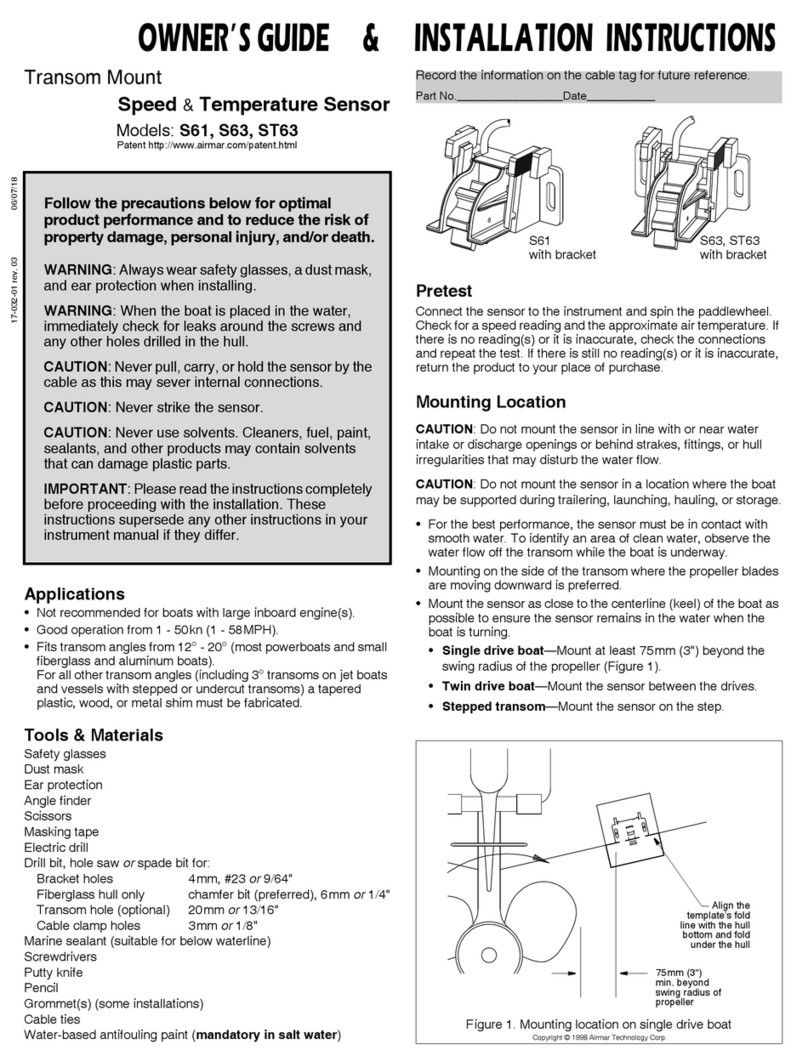
Airmar
Airmar EMEA S61 Owner's guide & installation instructions
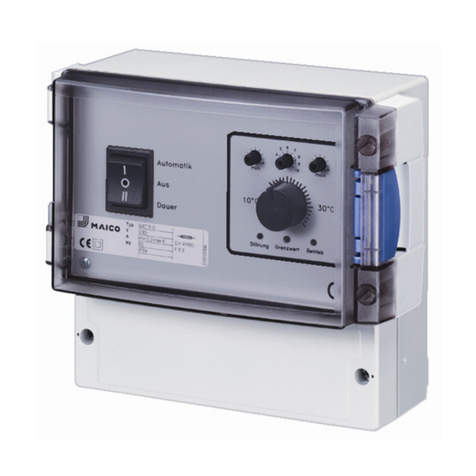
Maico
Maico EAT 6 G/1 Installation and operating instructions
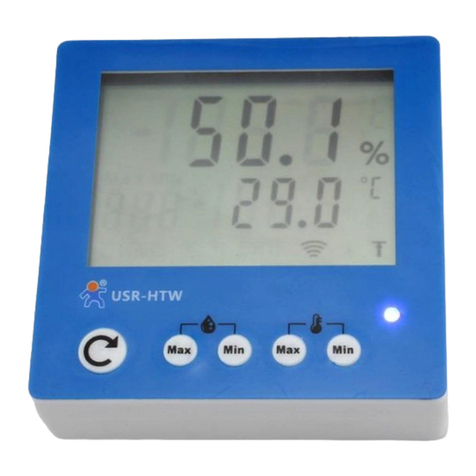
Jinan USR IOT Technology
Jinan USR IOT Technology LonHand USR-HTW user manual
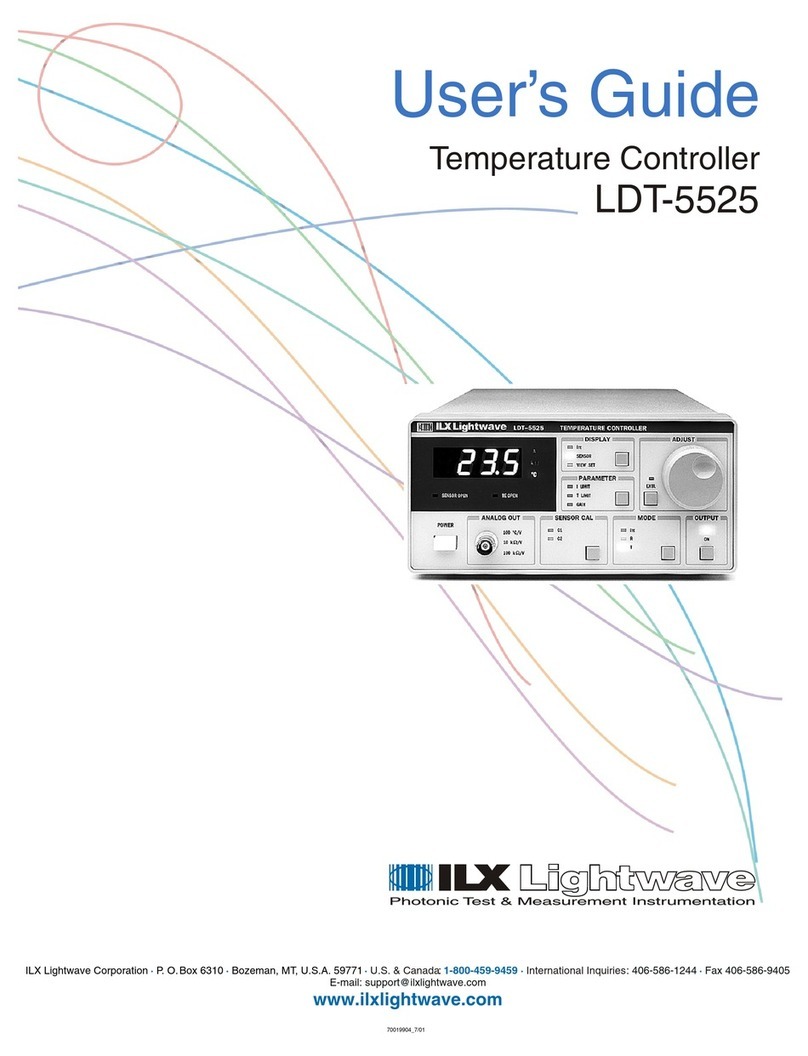
ILX Lightwave
ILX Lightwave LDT-5525 user guide
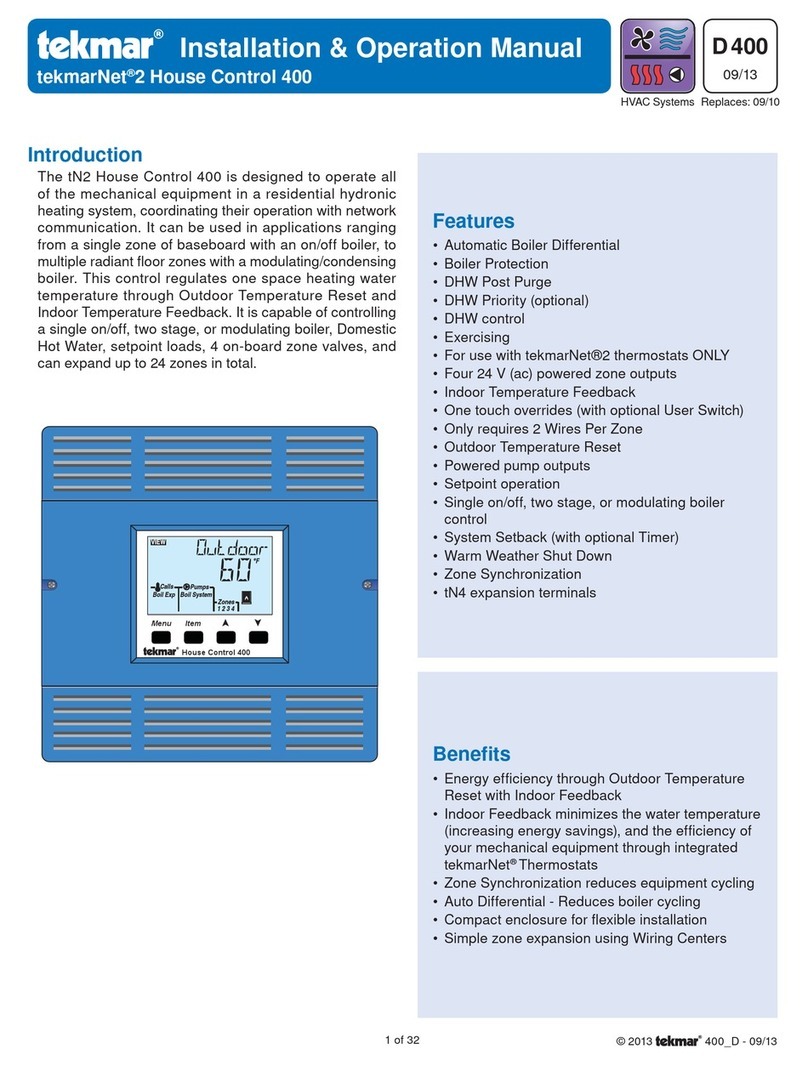
Tekmar
Tekmar tN2 house control 400 Installation and operation manual

Bosch
Bosch FR 120 Installation and operating instructions
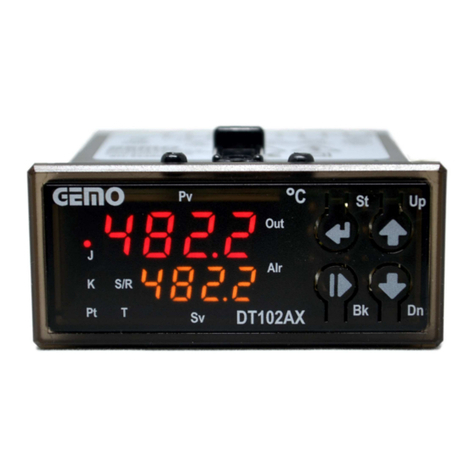
Gemo
Gemo DT102AX installation instructions
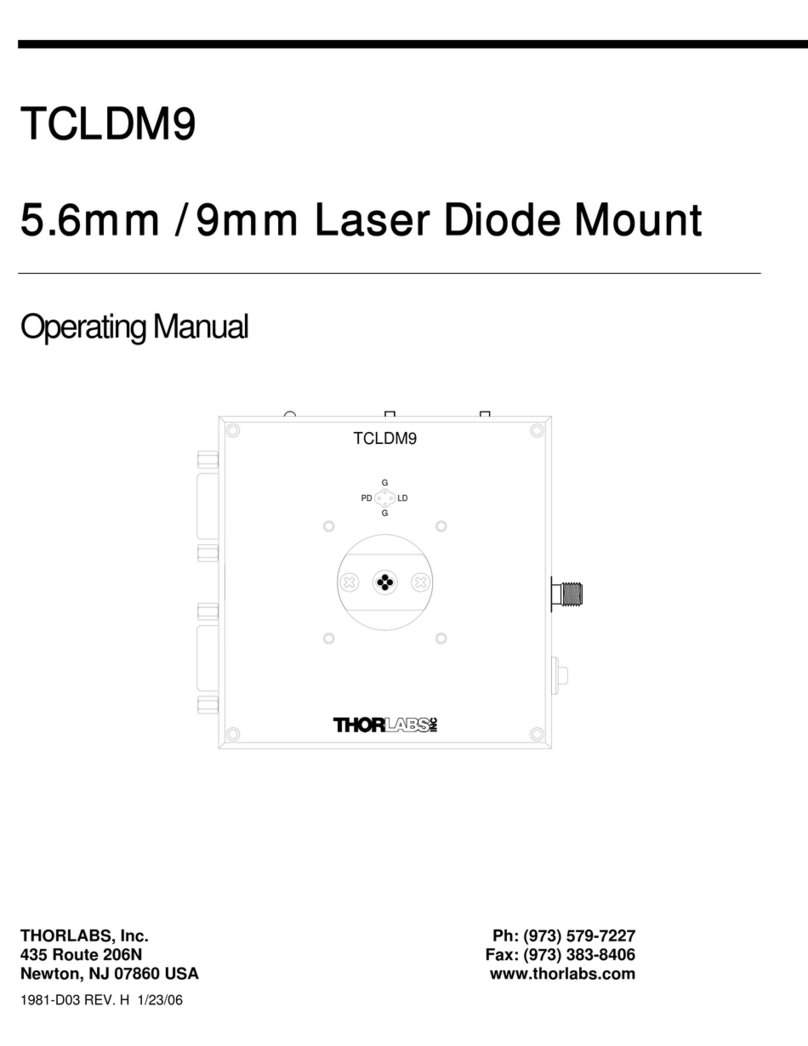
THORLABS
THORLABS TCLDM9 operating manual
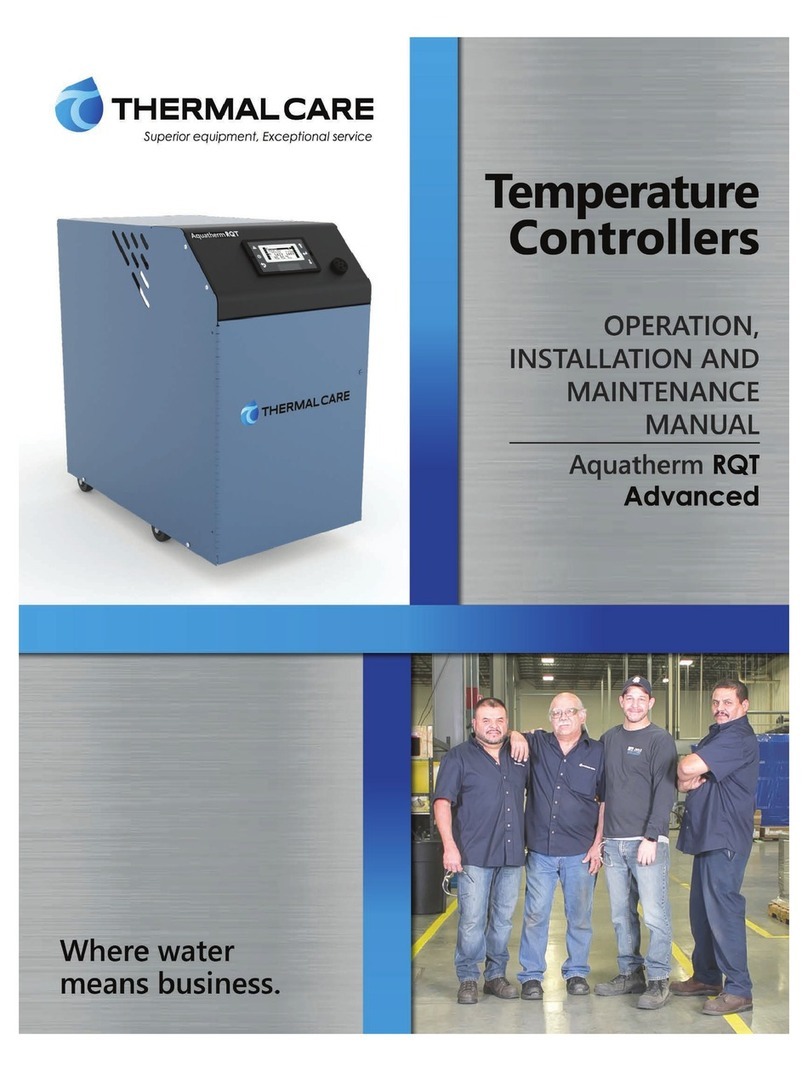
Thermal Care
Thermal Care Aquatherm RQT Advanced Operation, installation, and maintenance manual
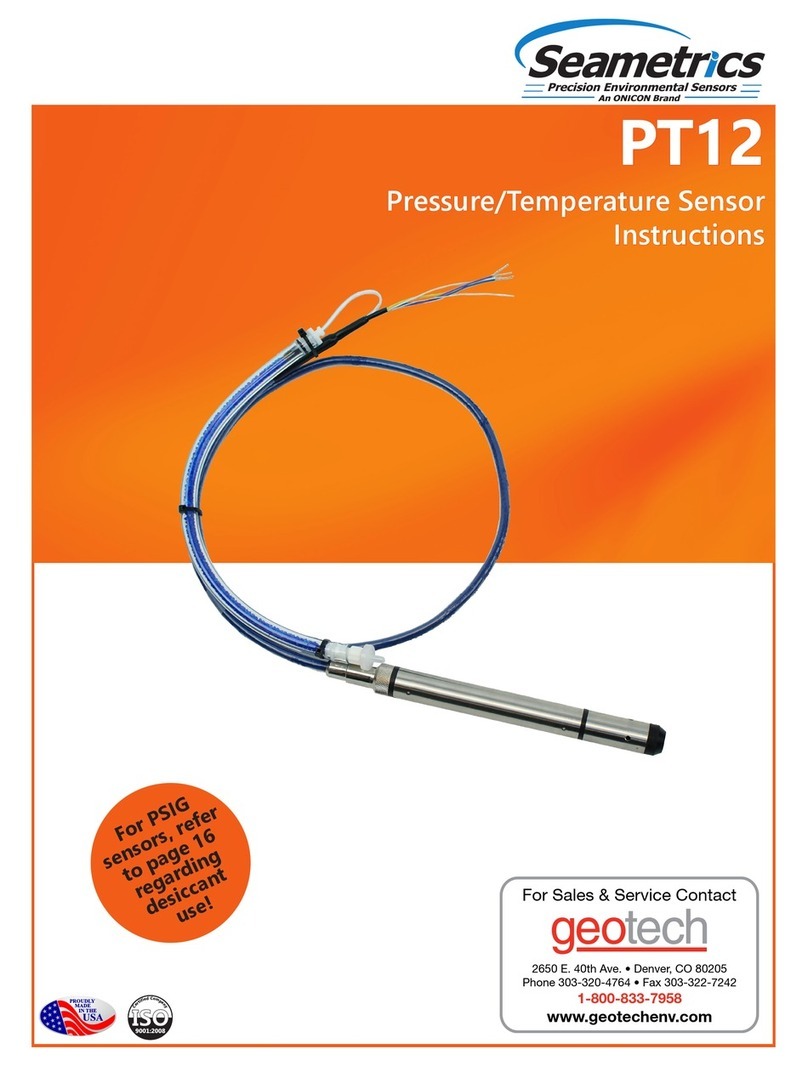
Seametrics
Seametrics PT12 instructions
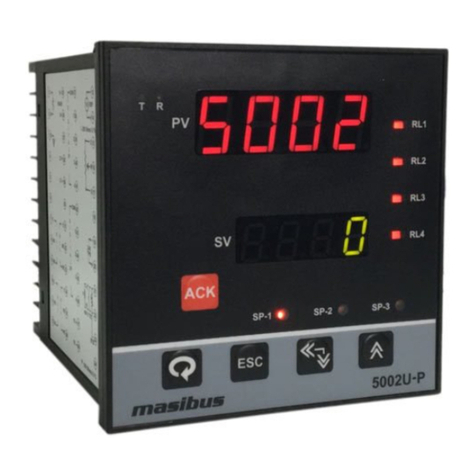
Masibus
Masibus 5002U-P user manual
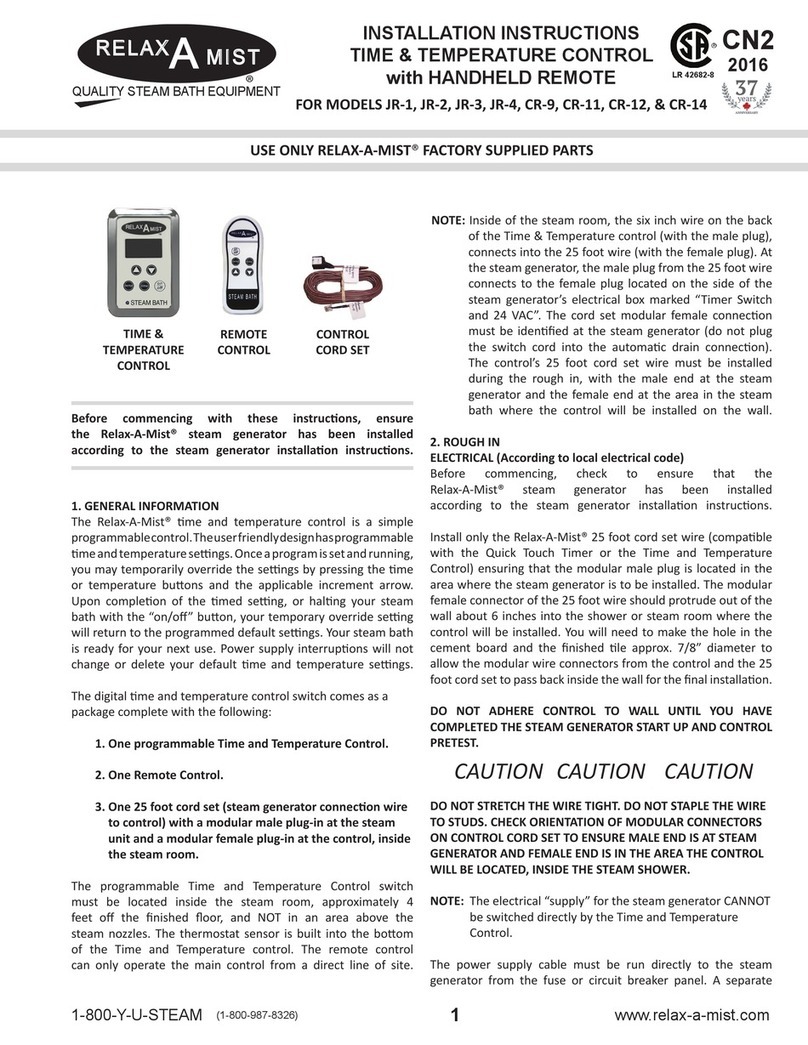
RELAX-A-MIST
RELAX-A-MIST CR-9 installation instructions
